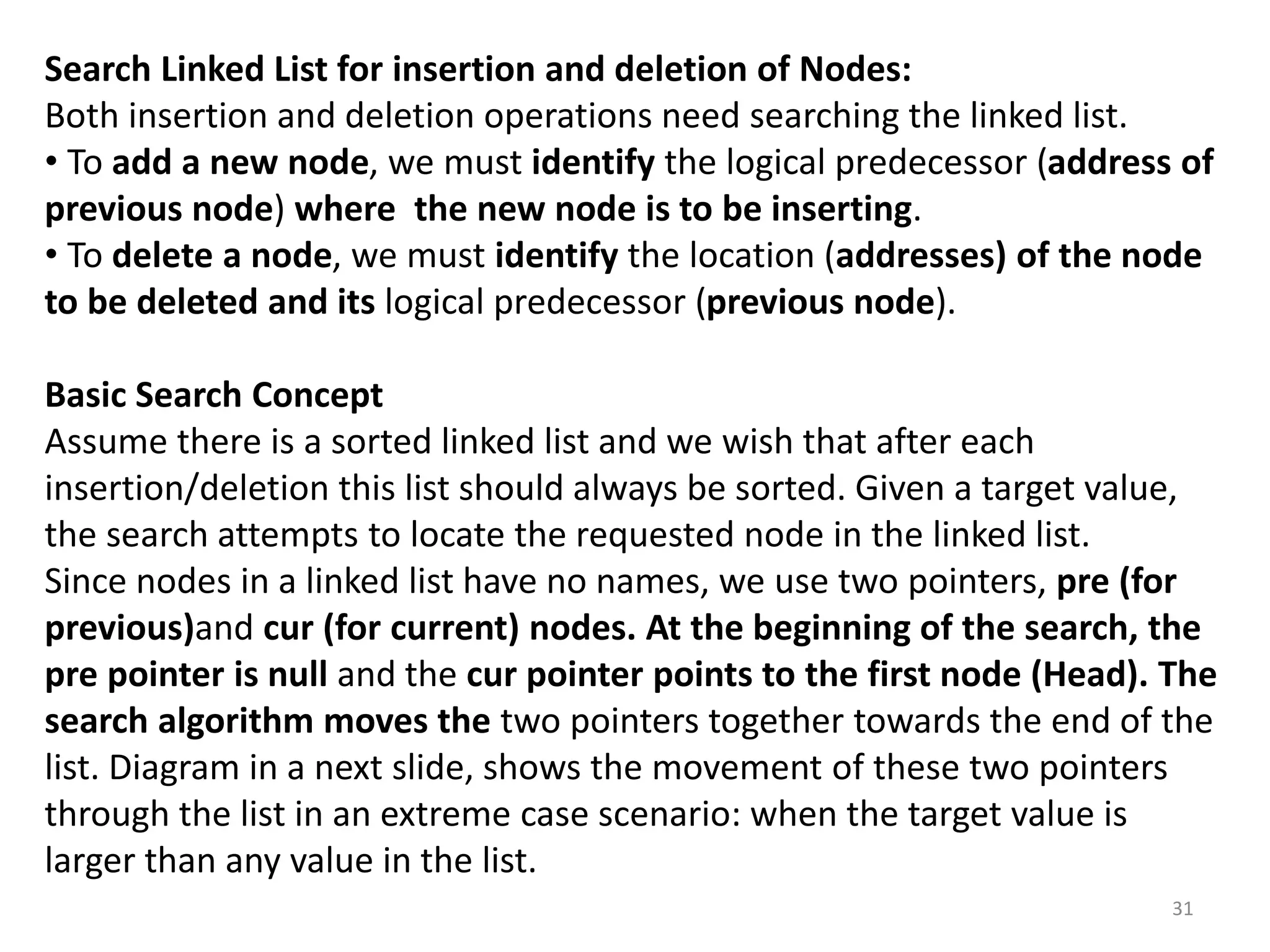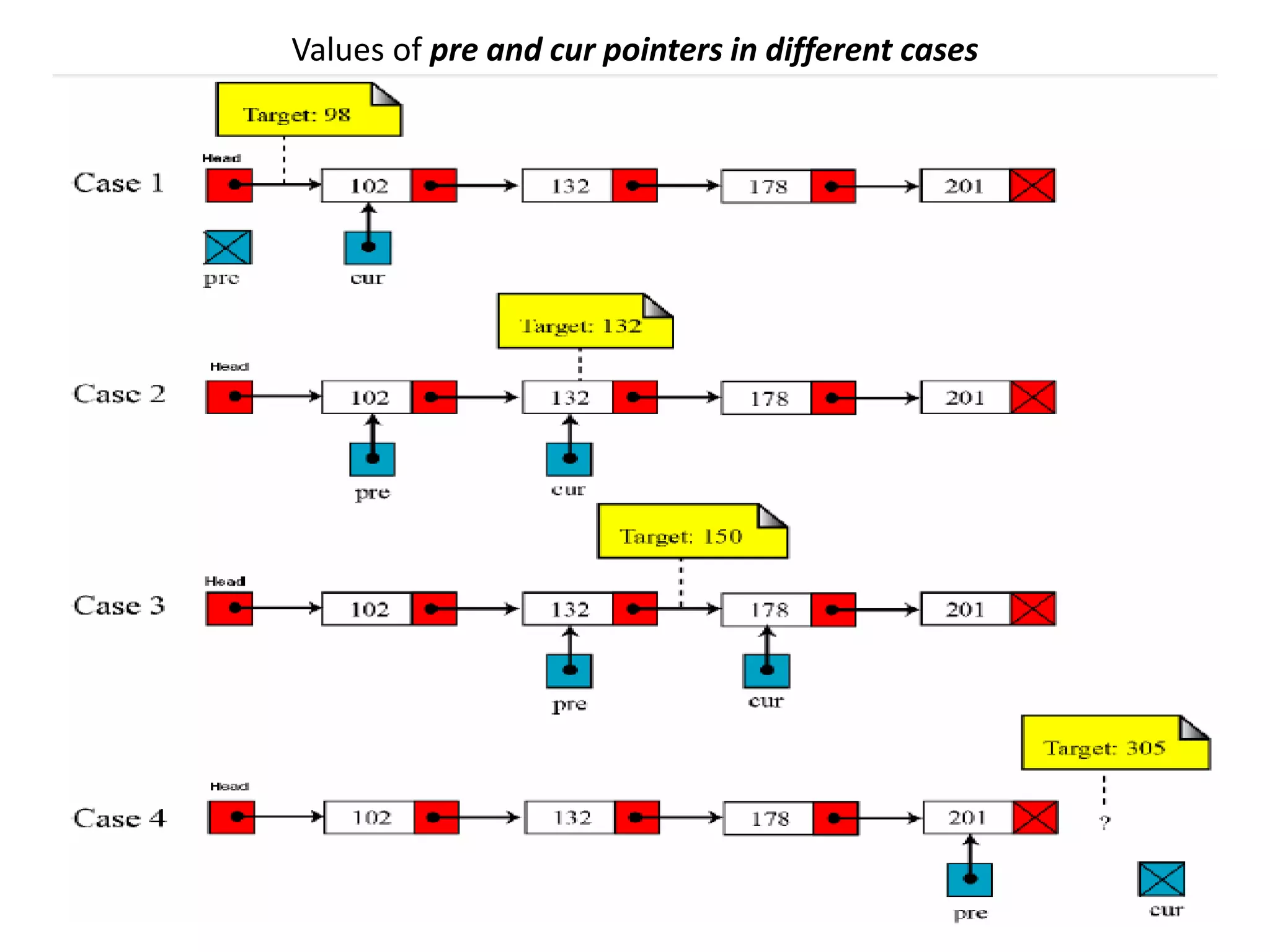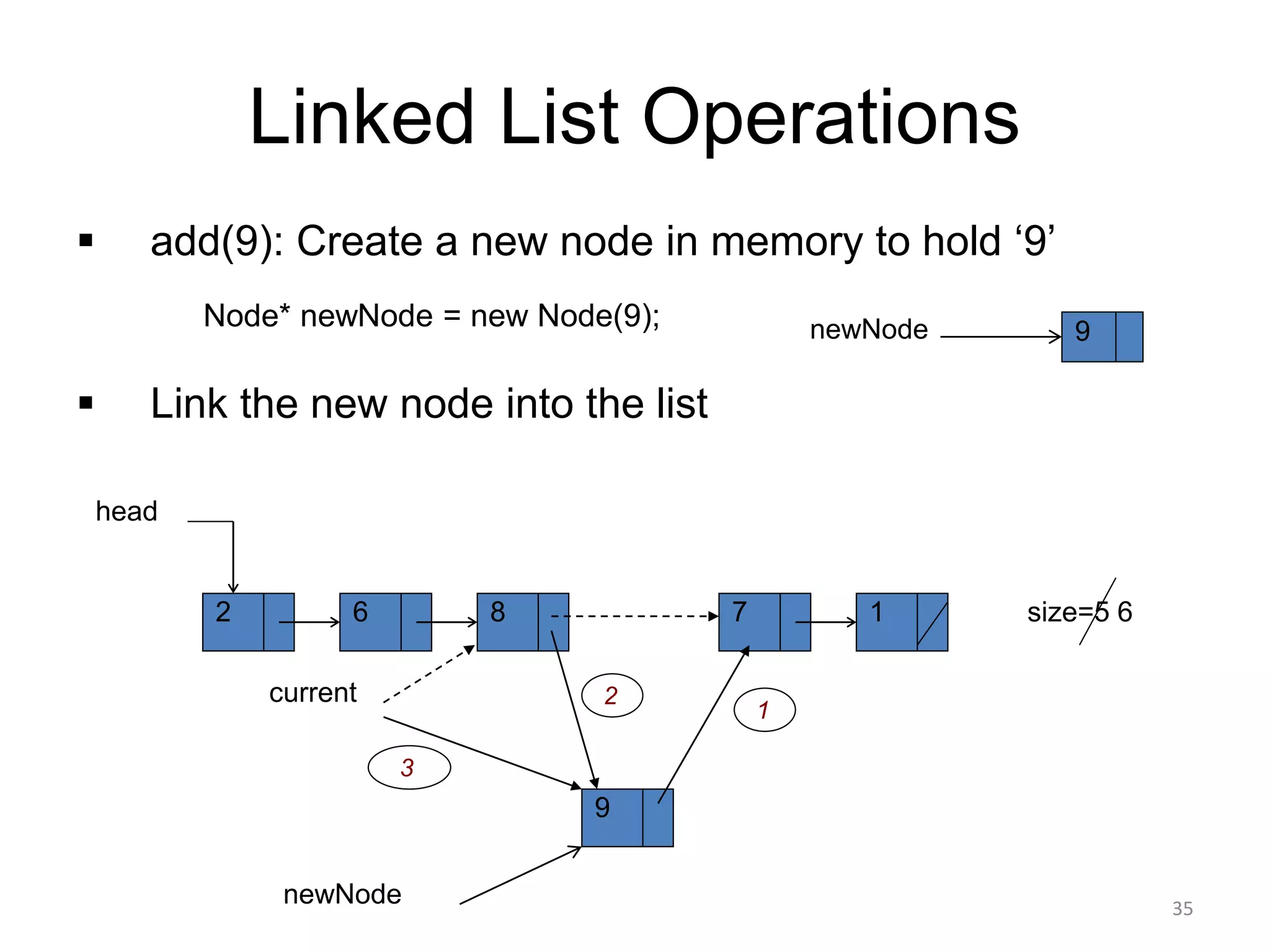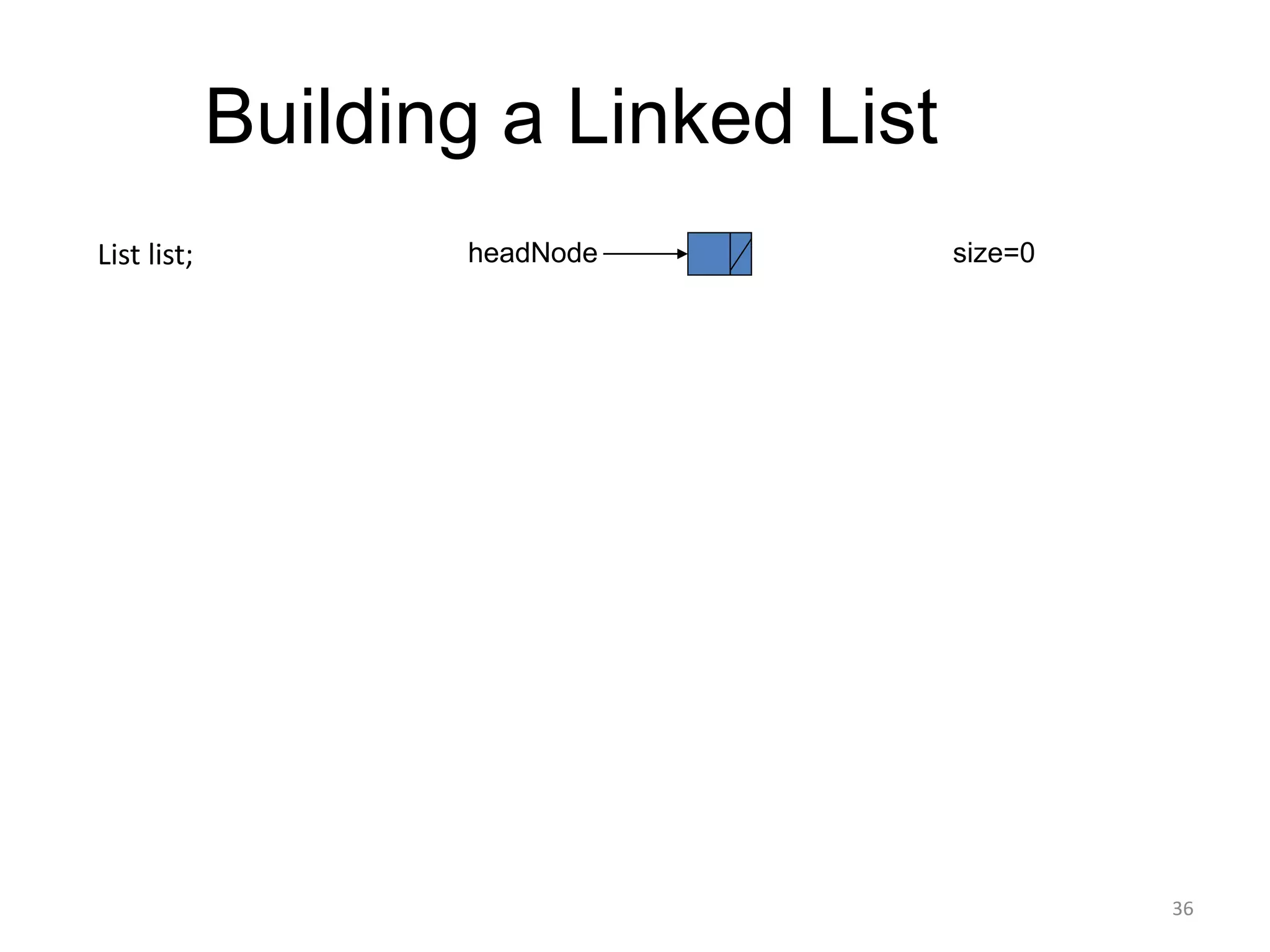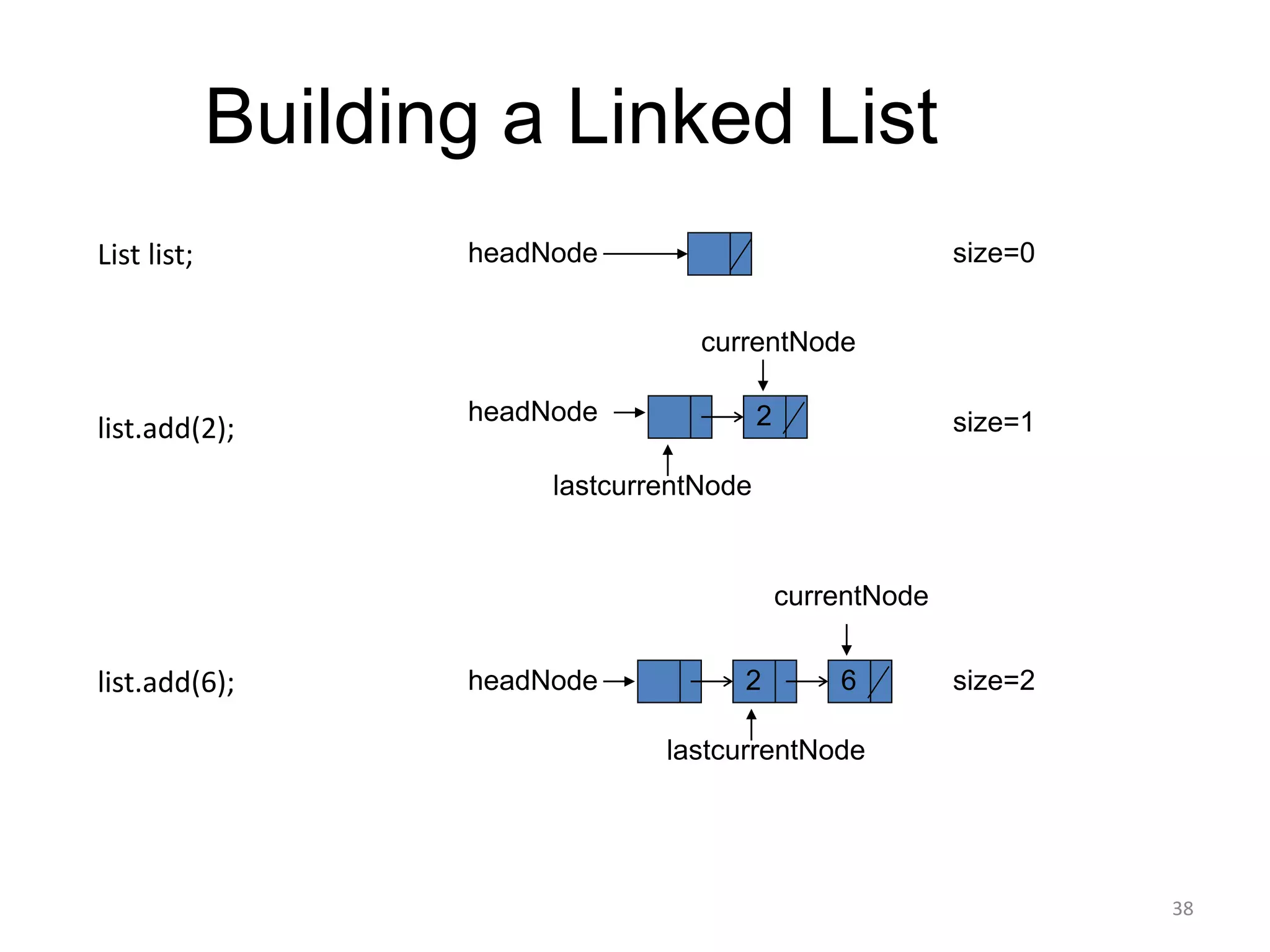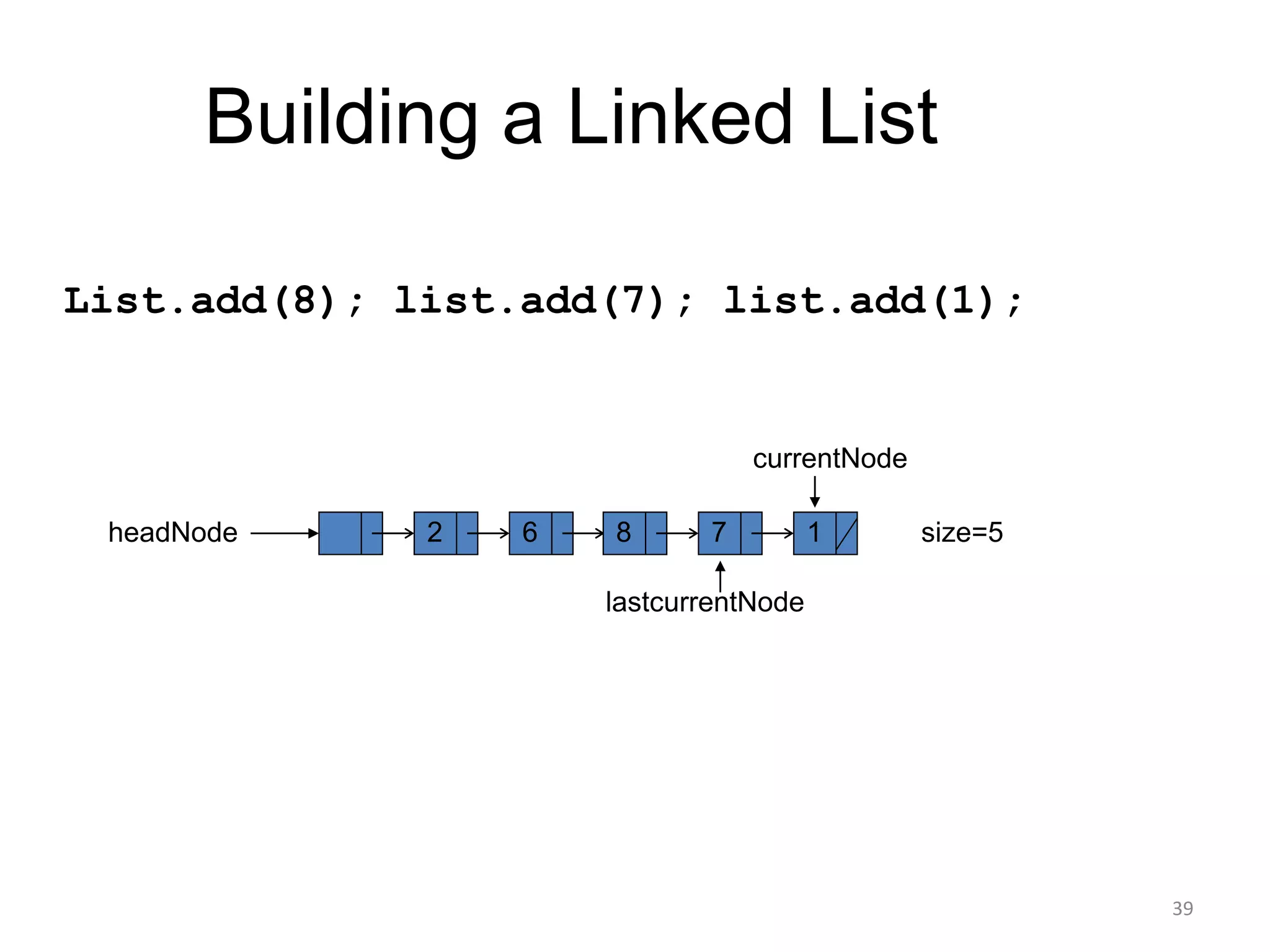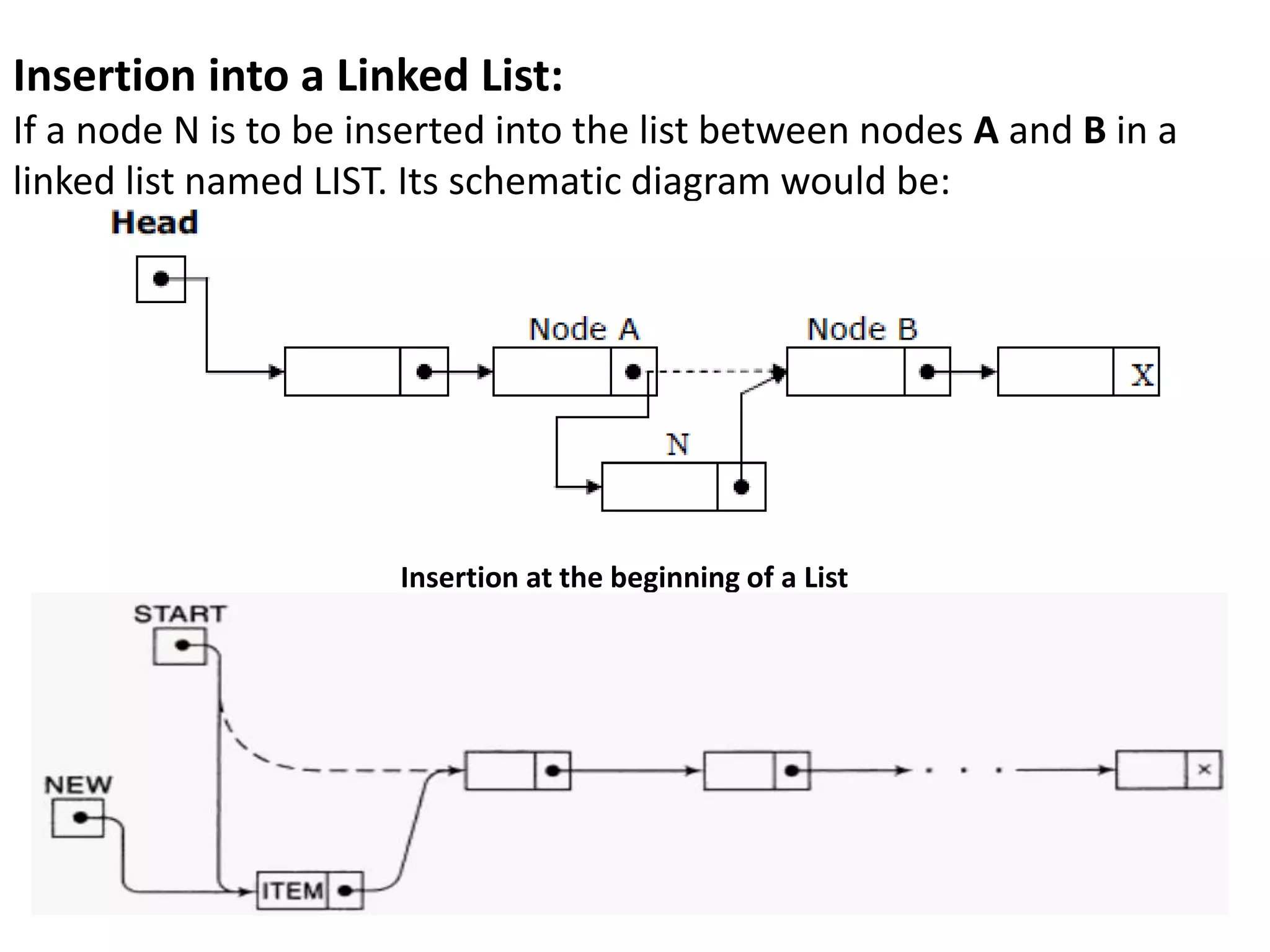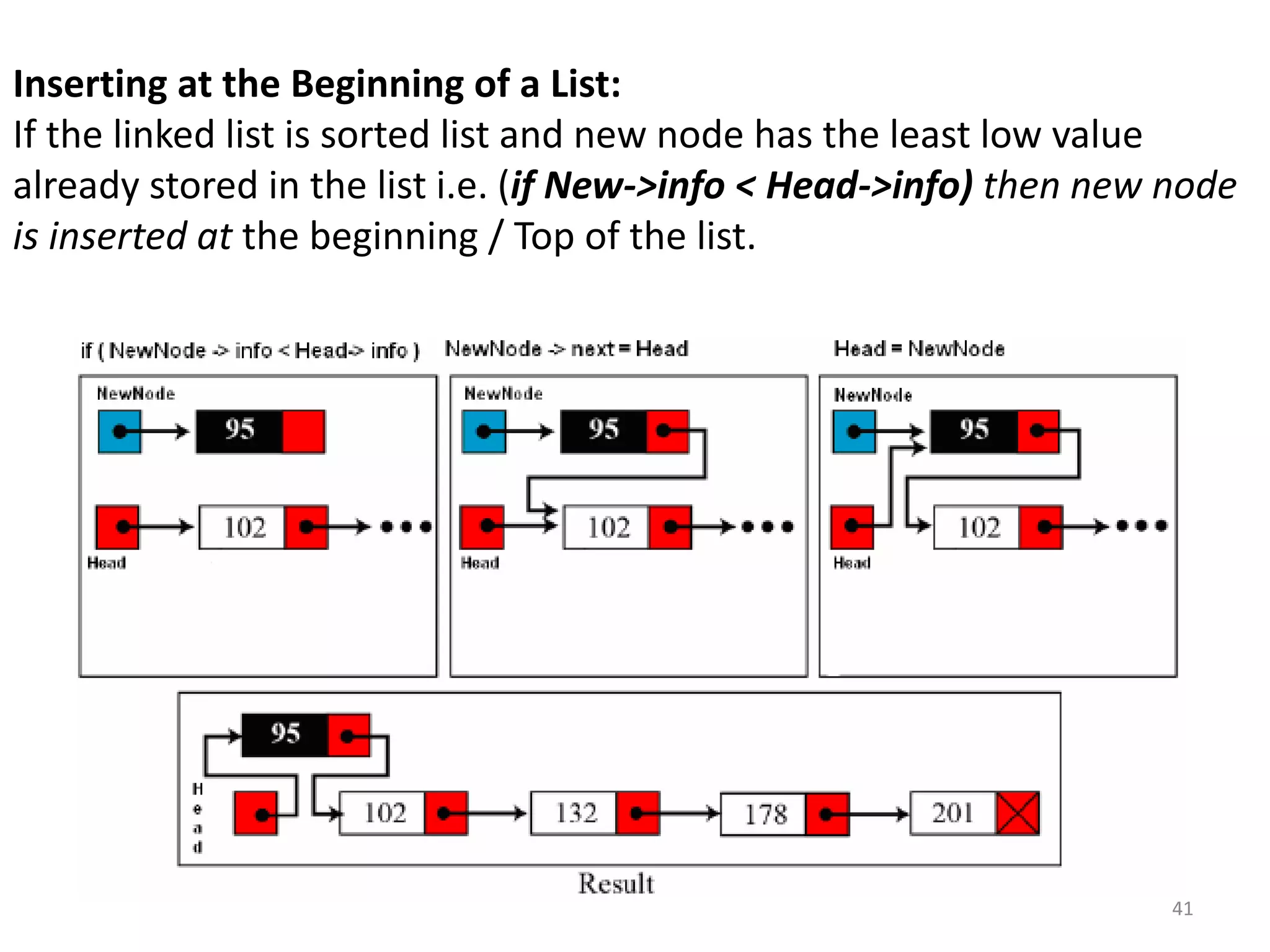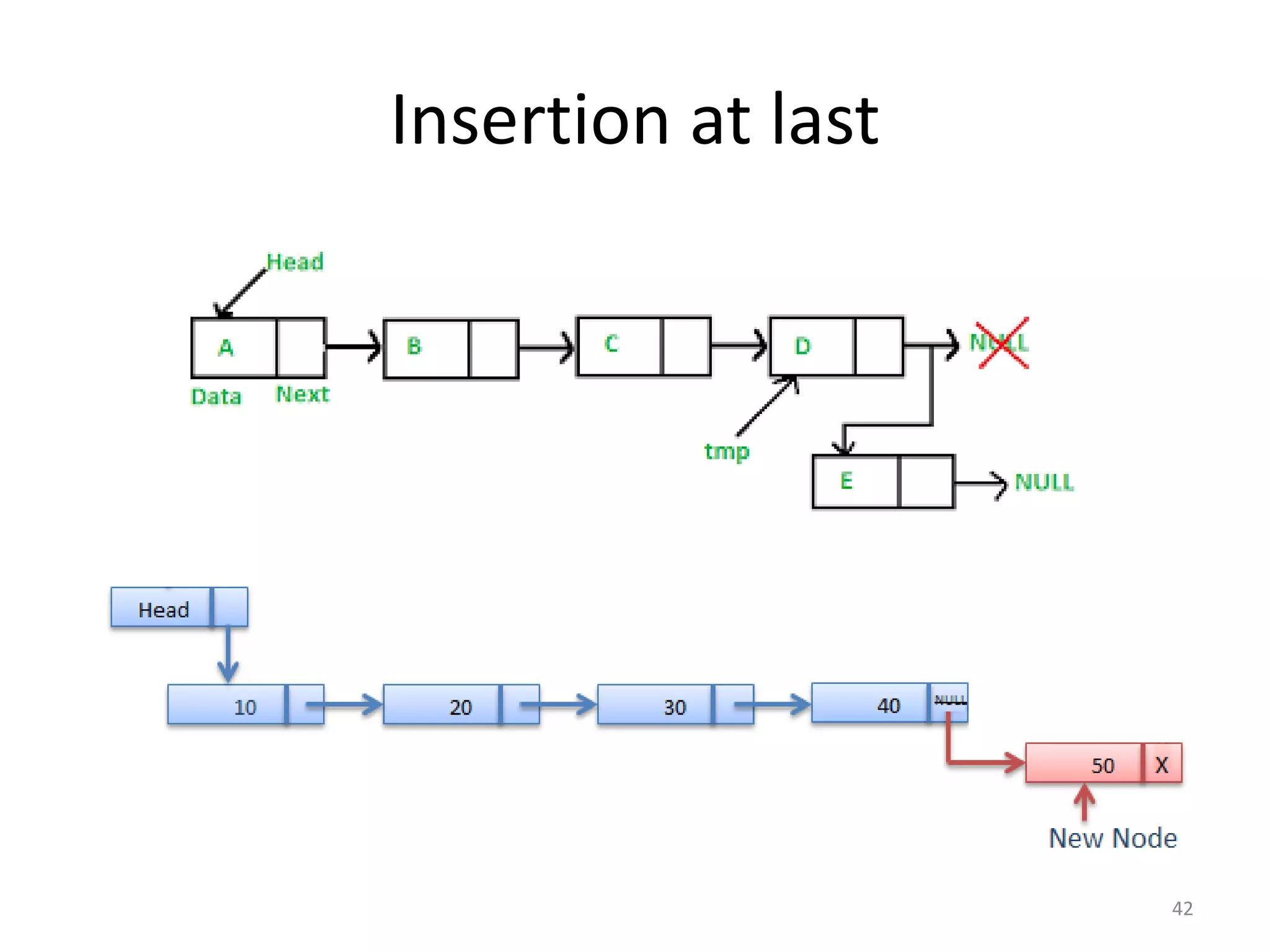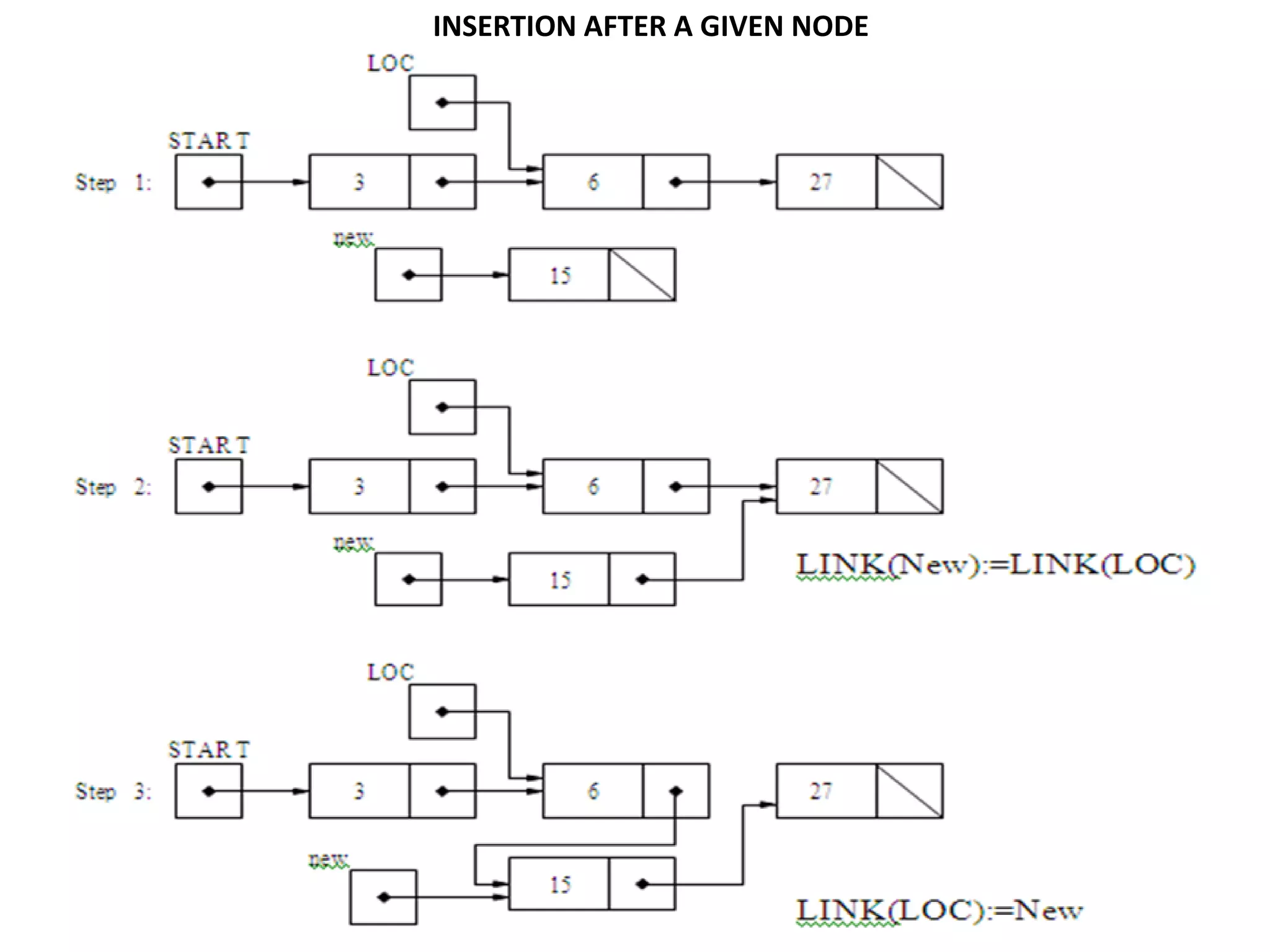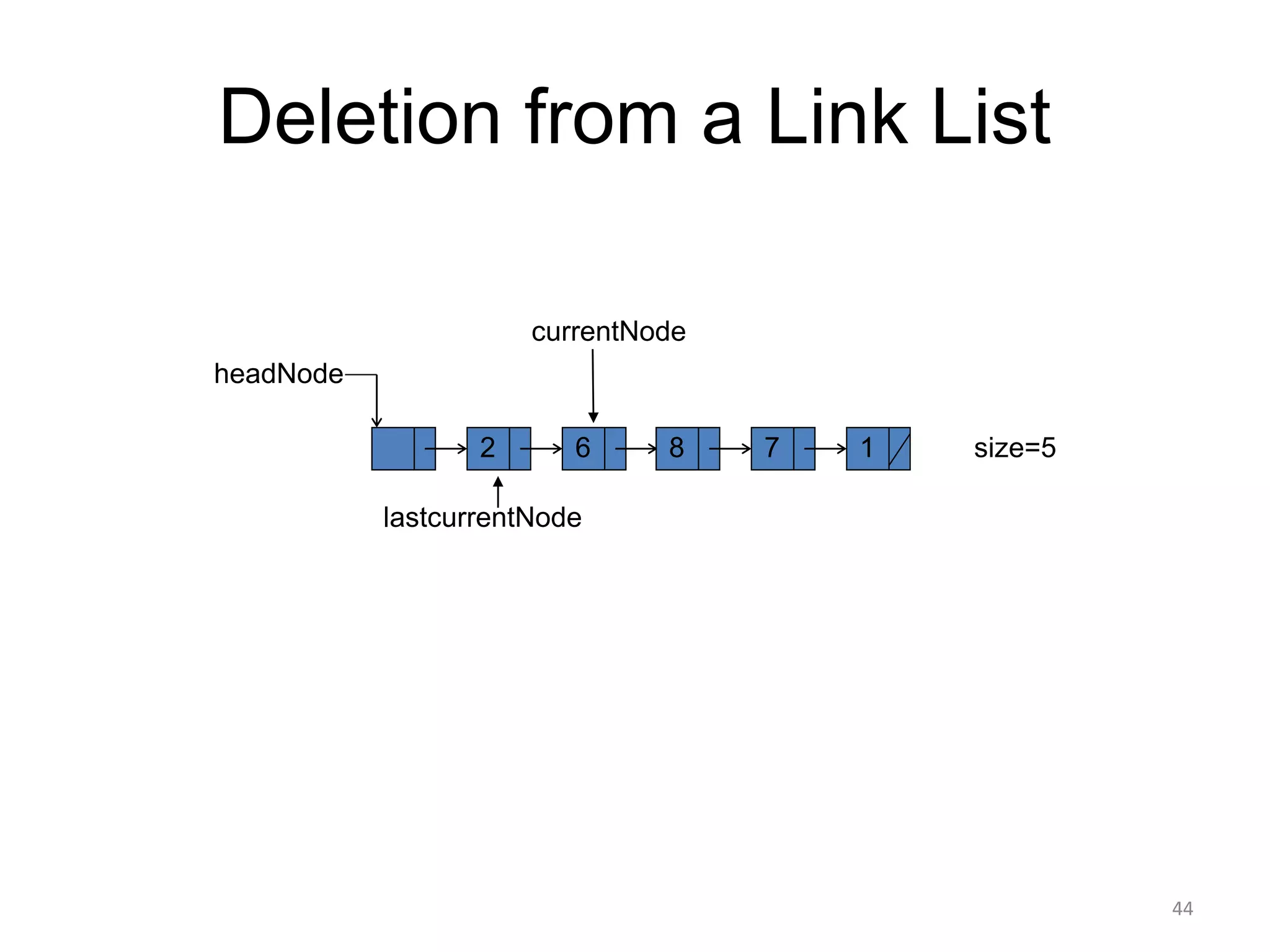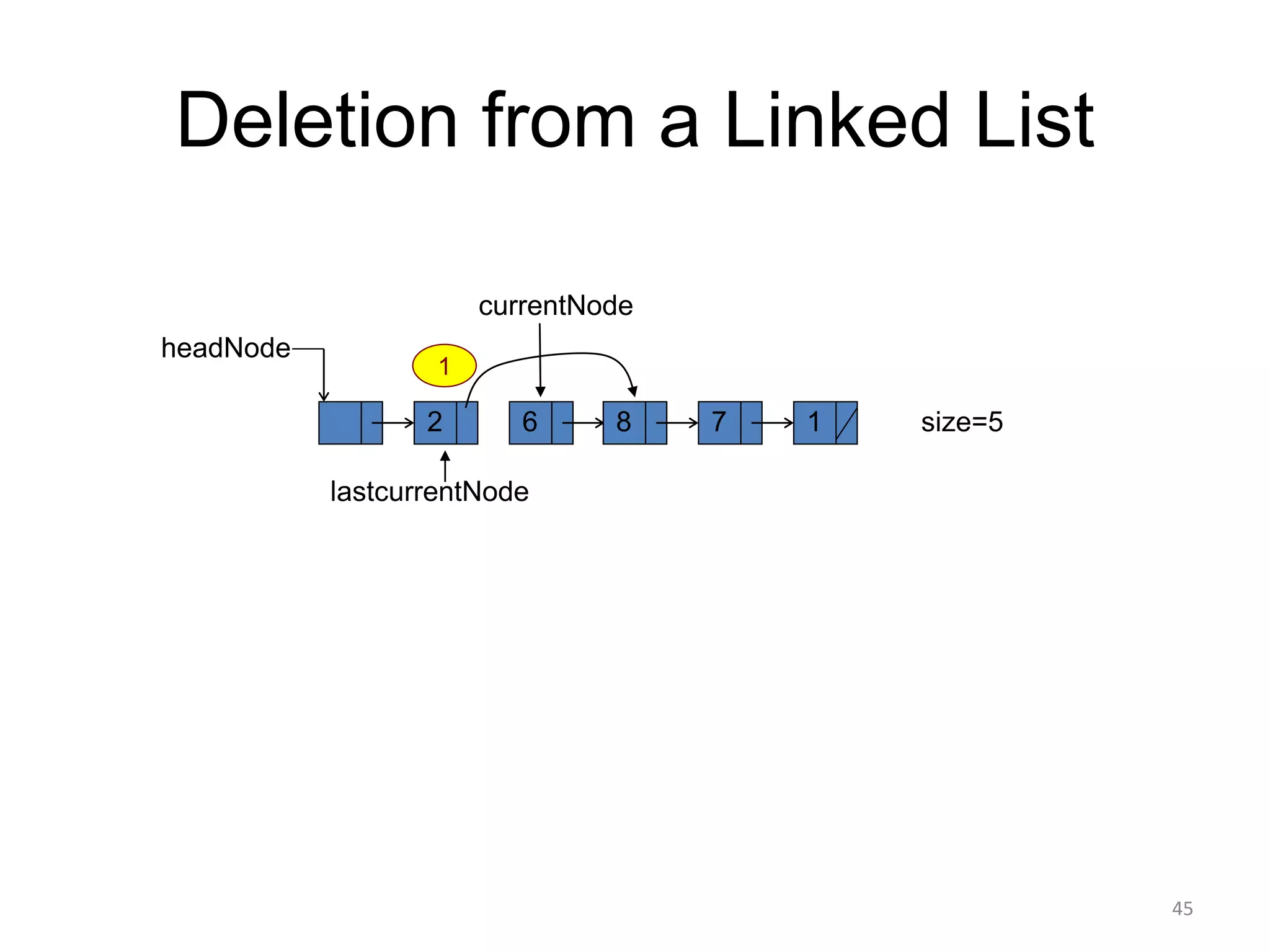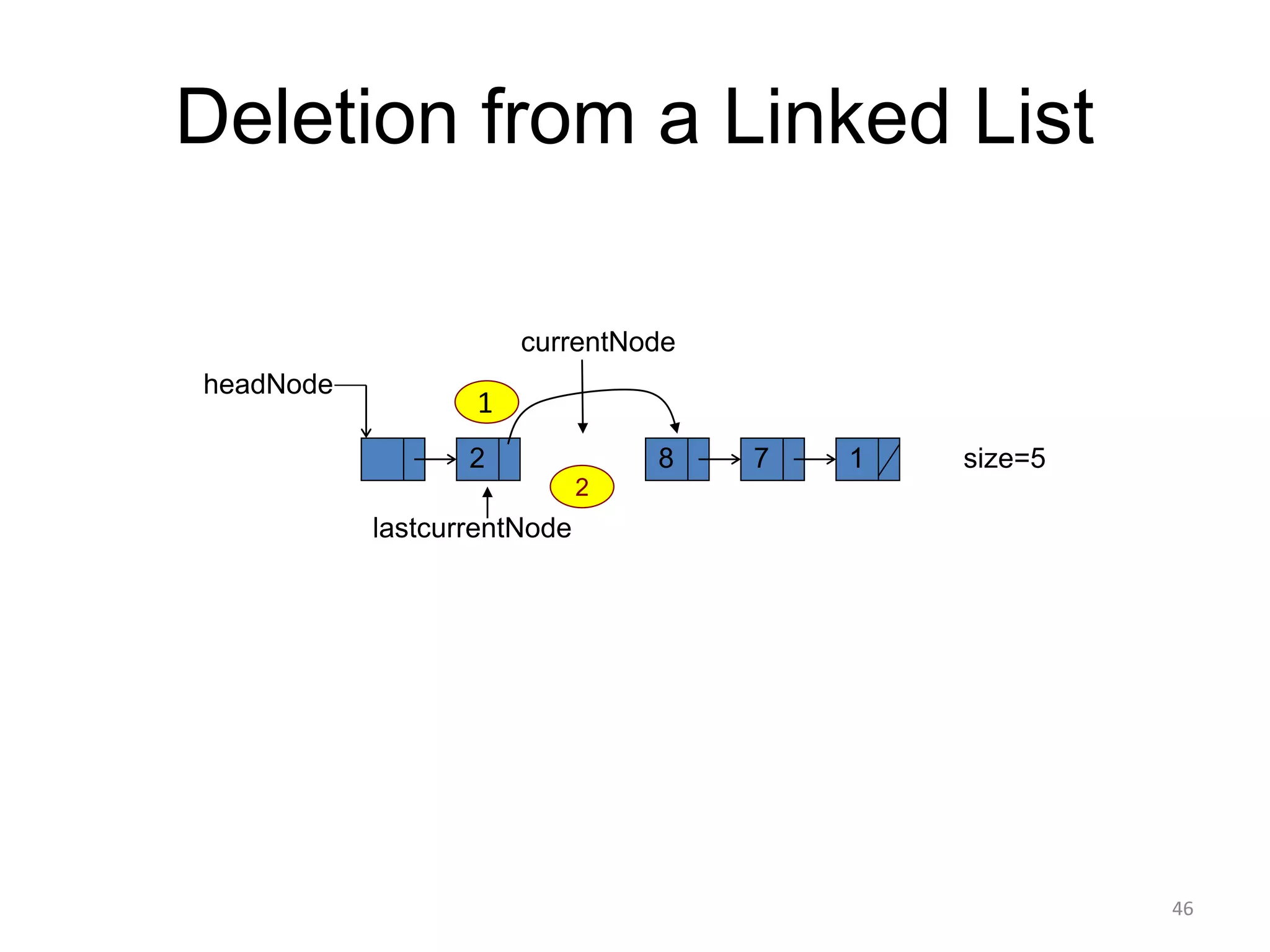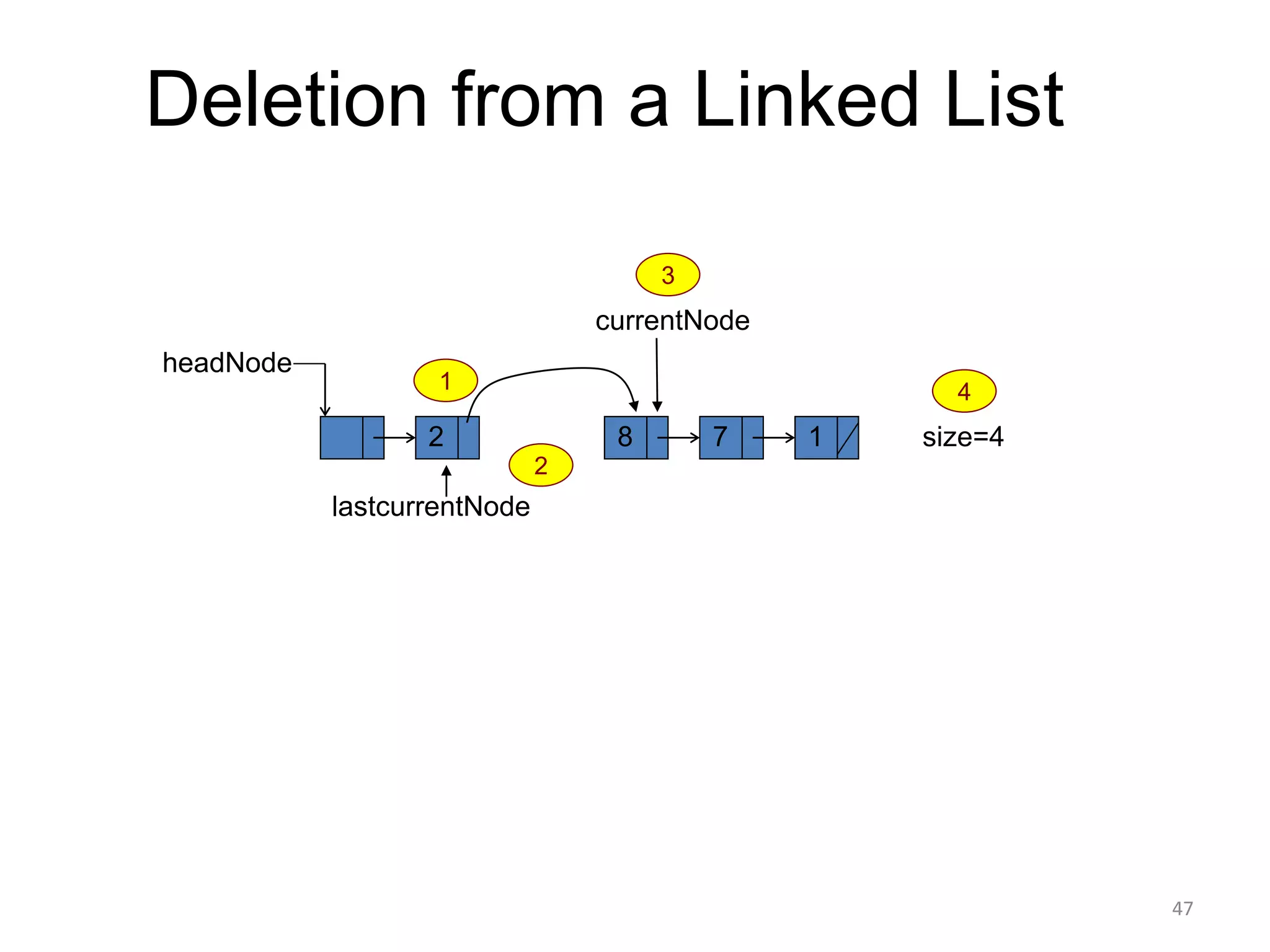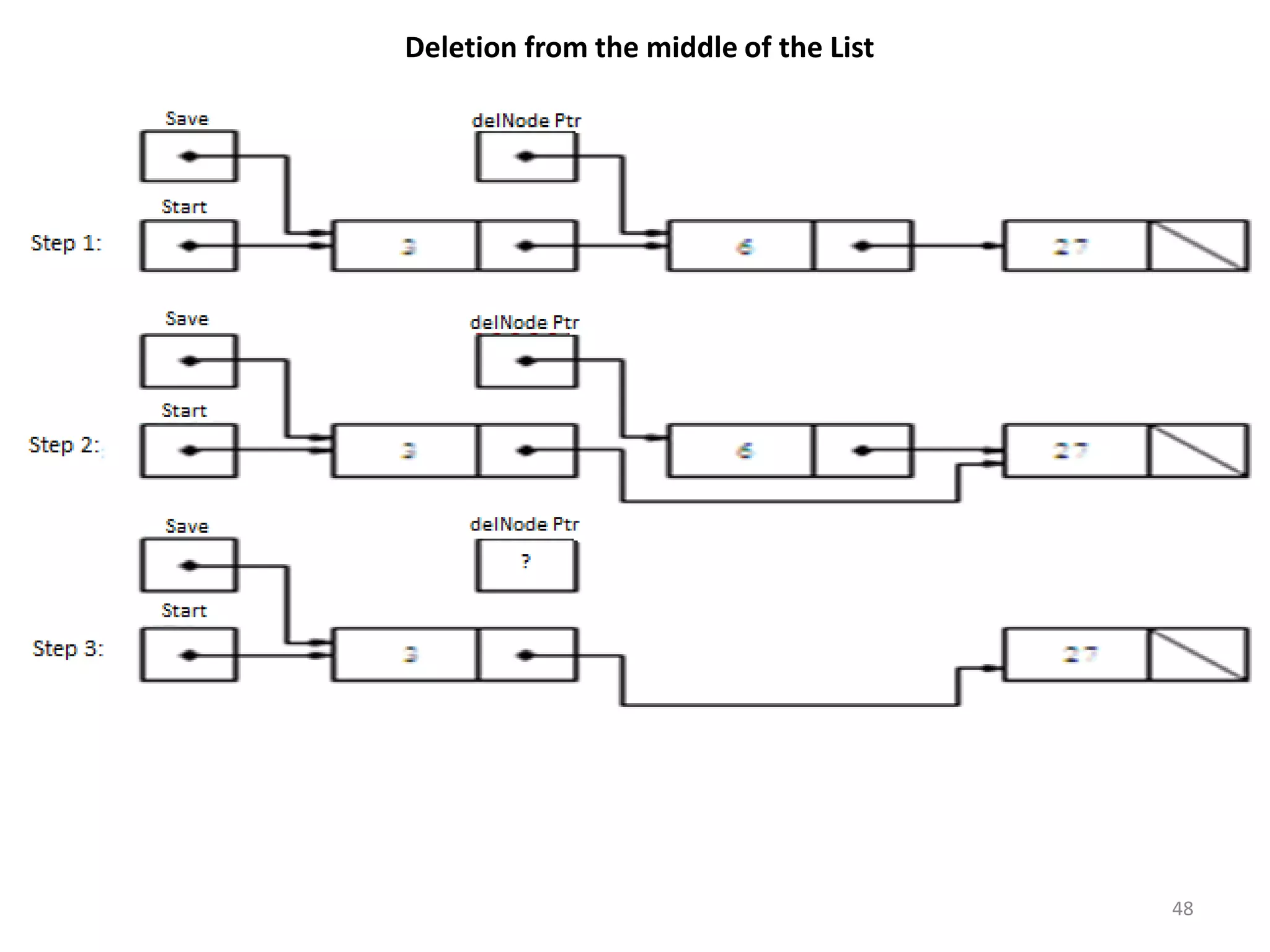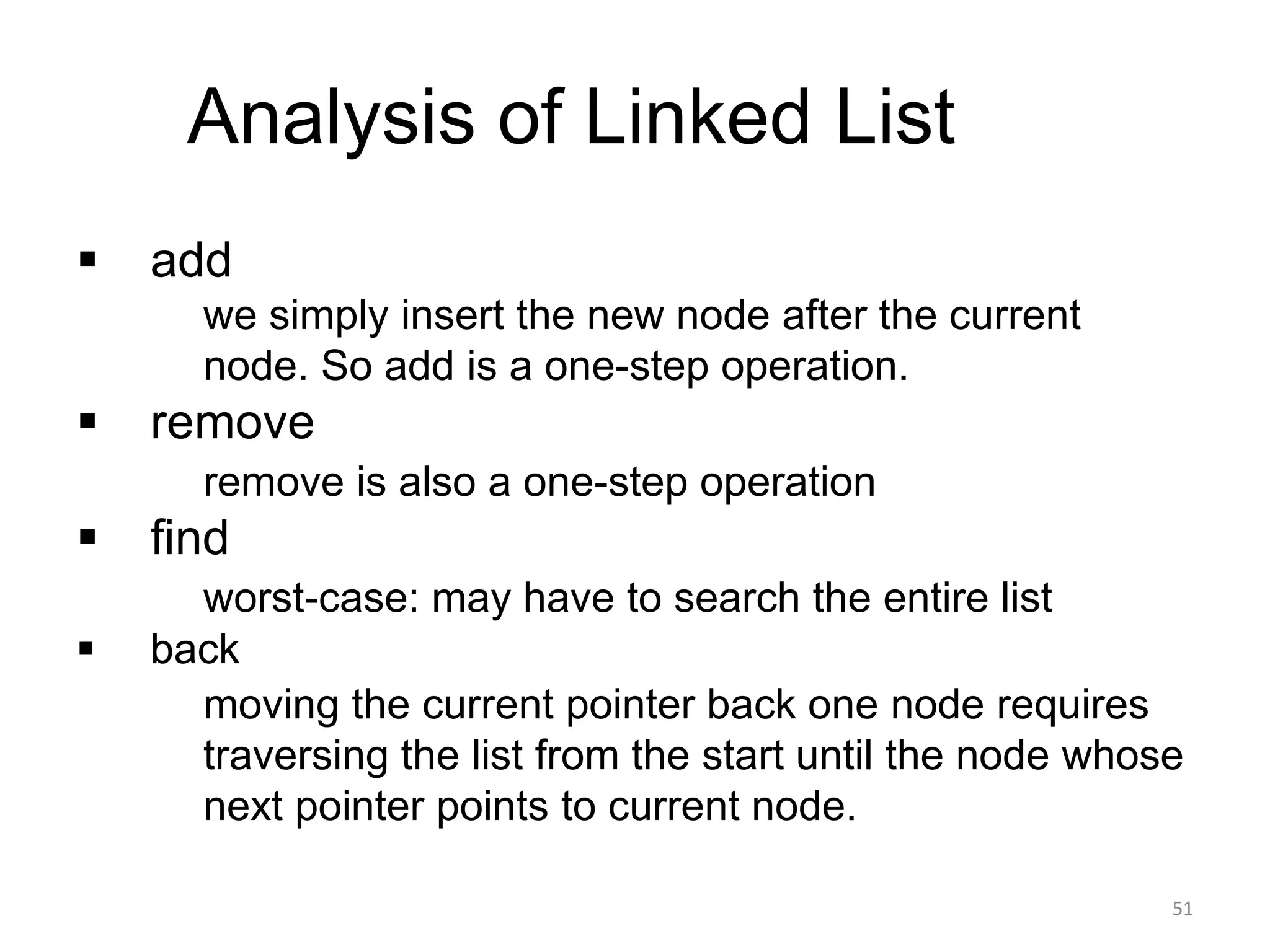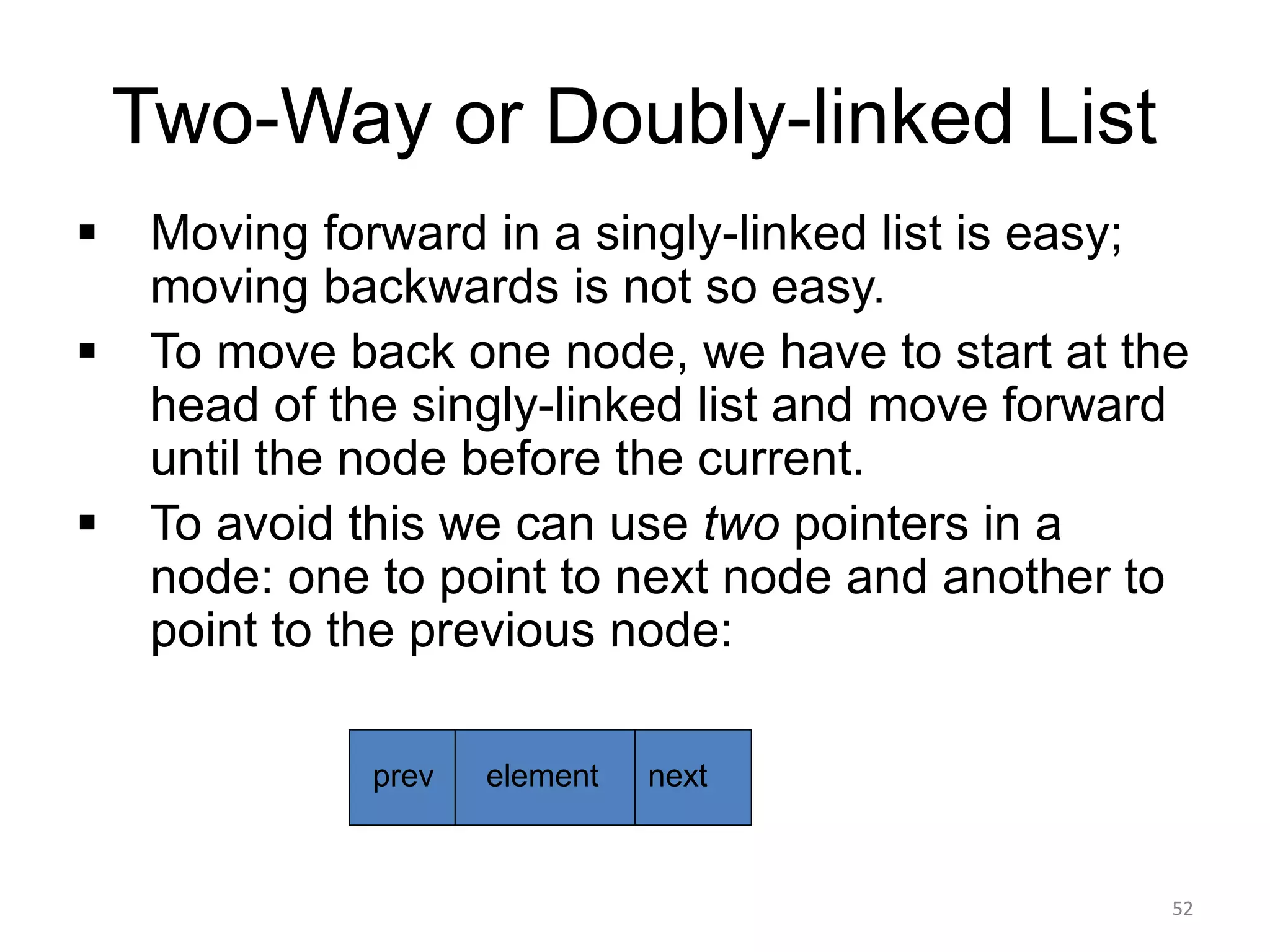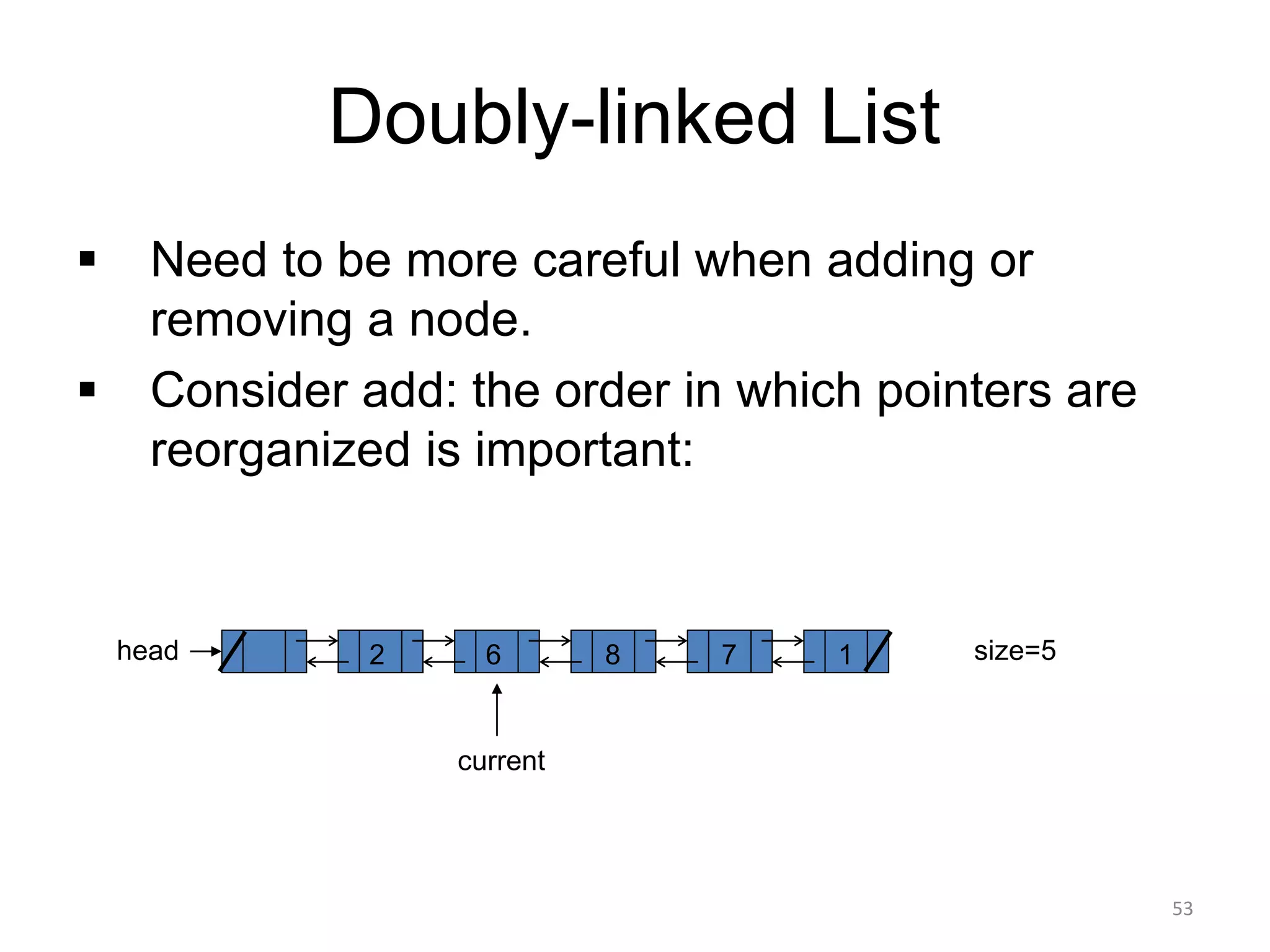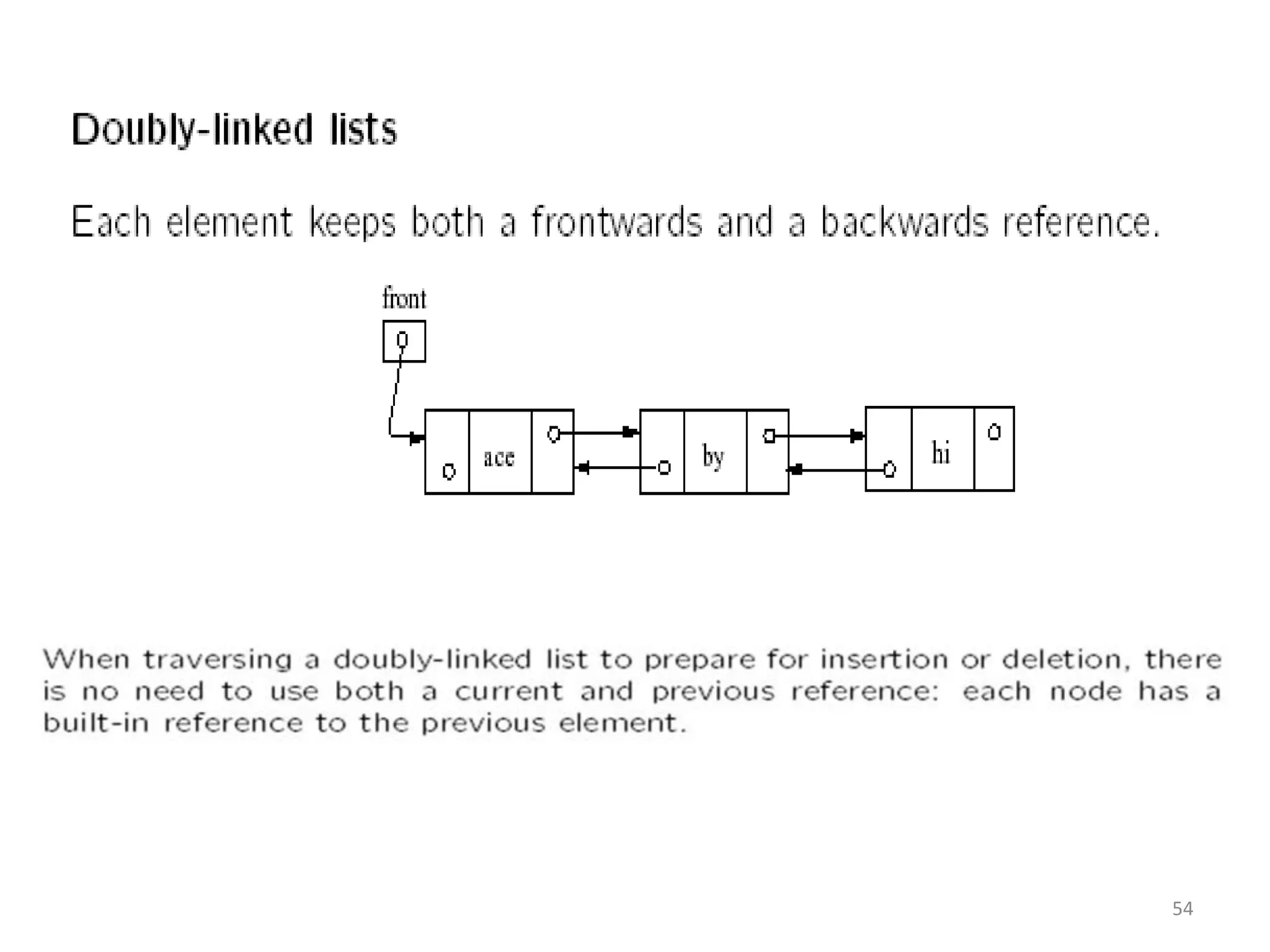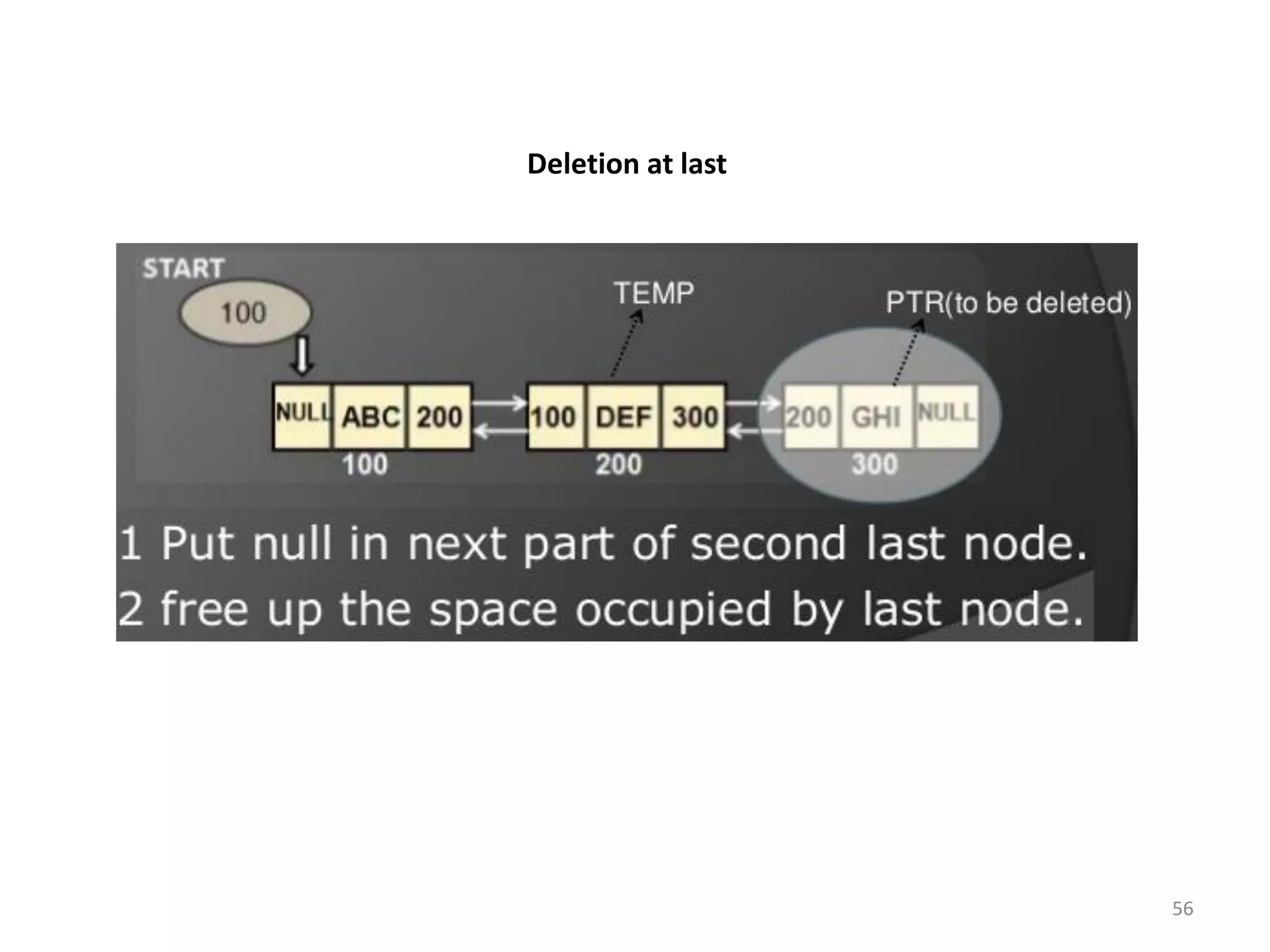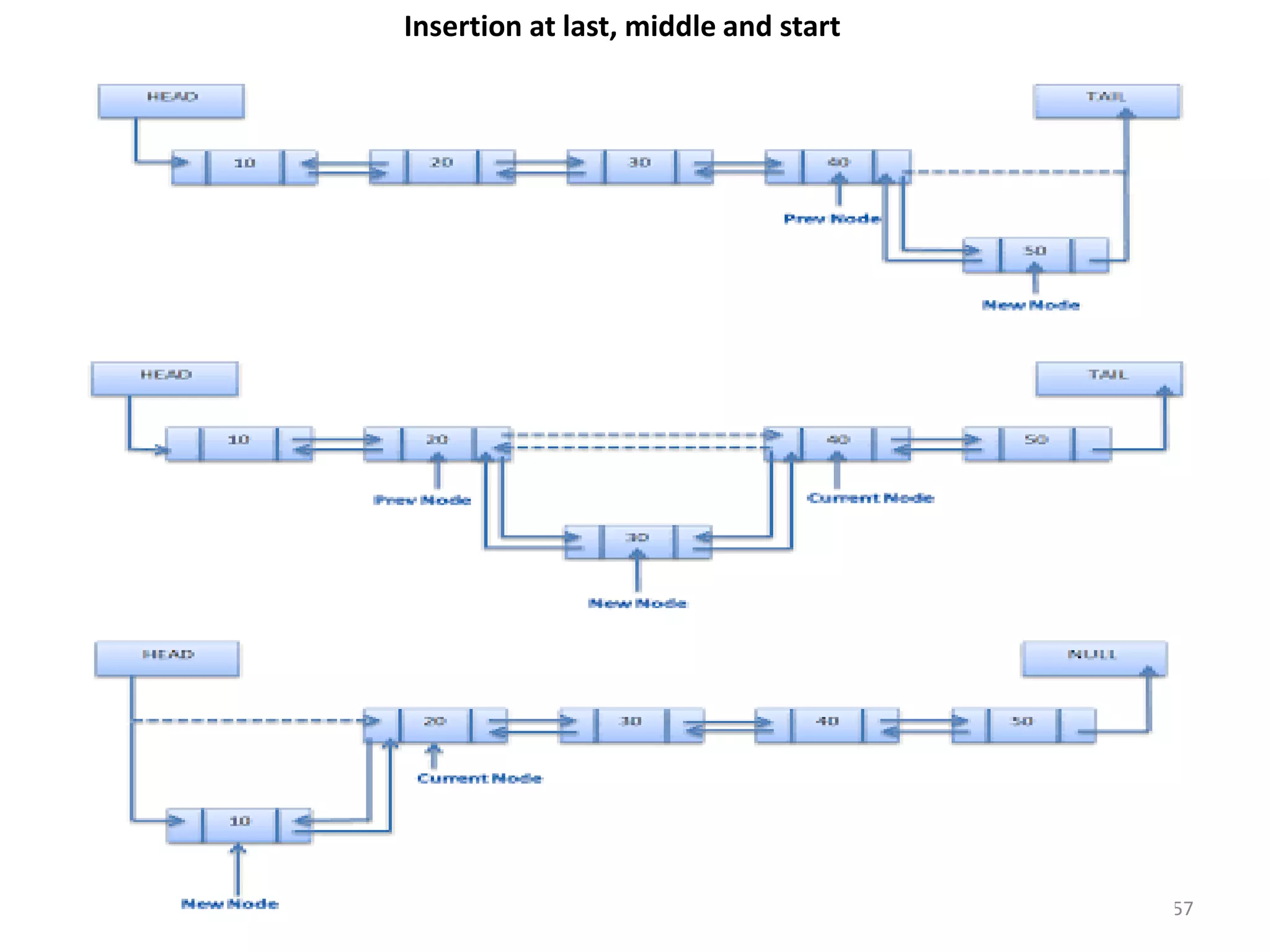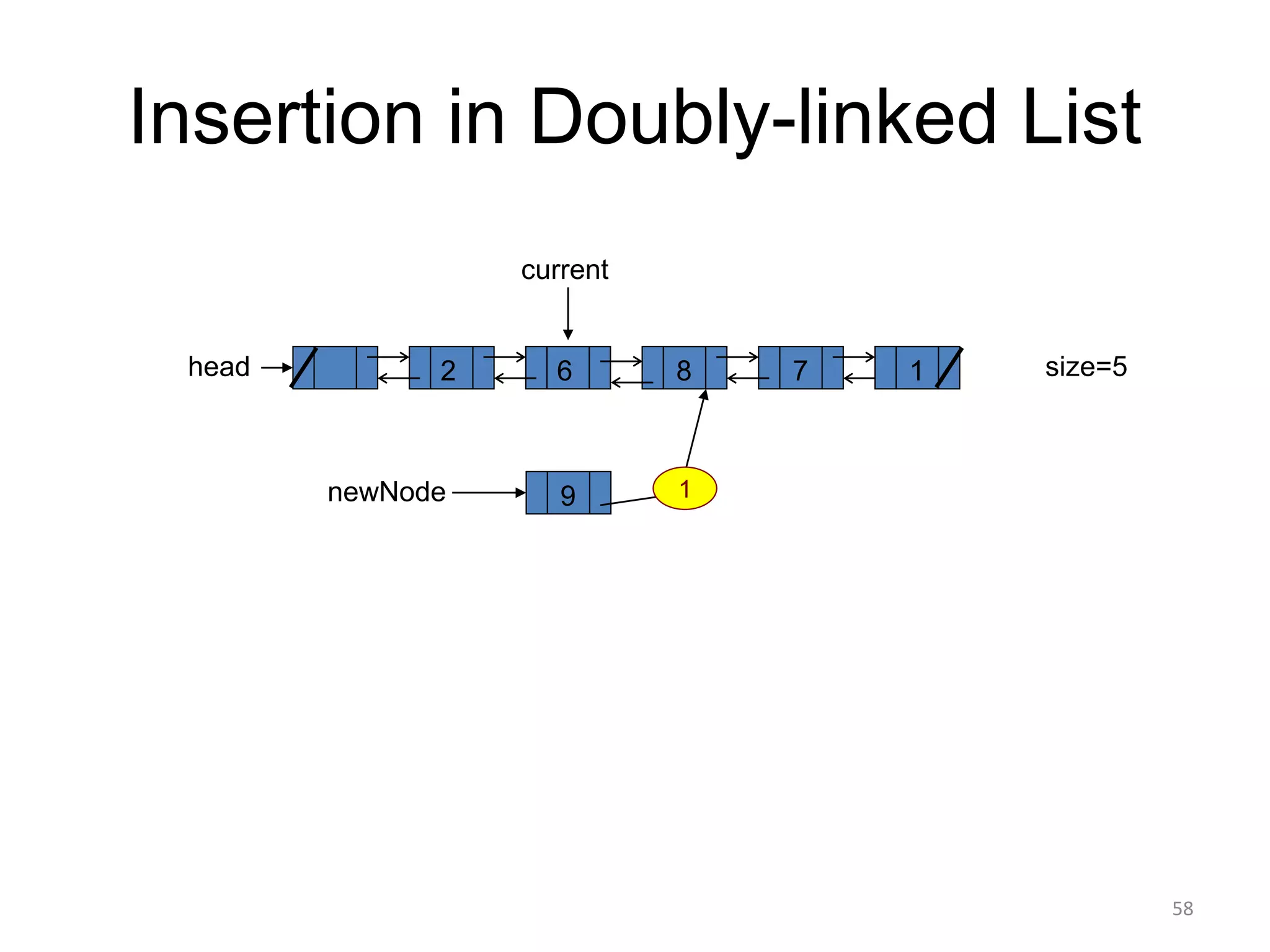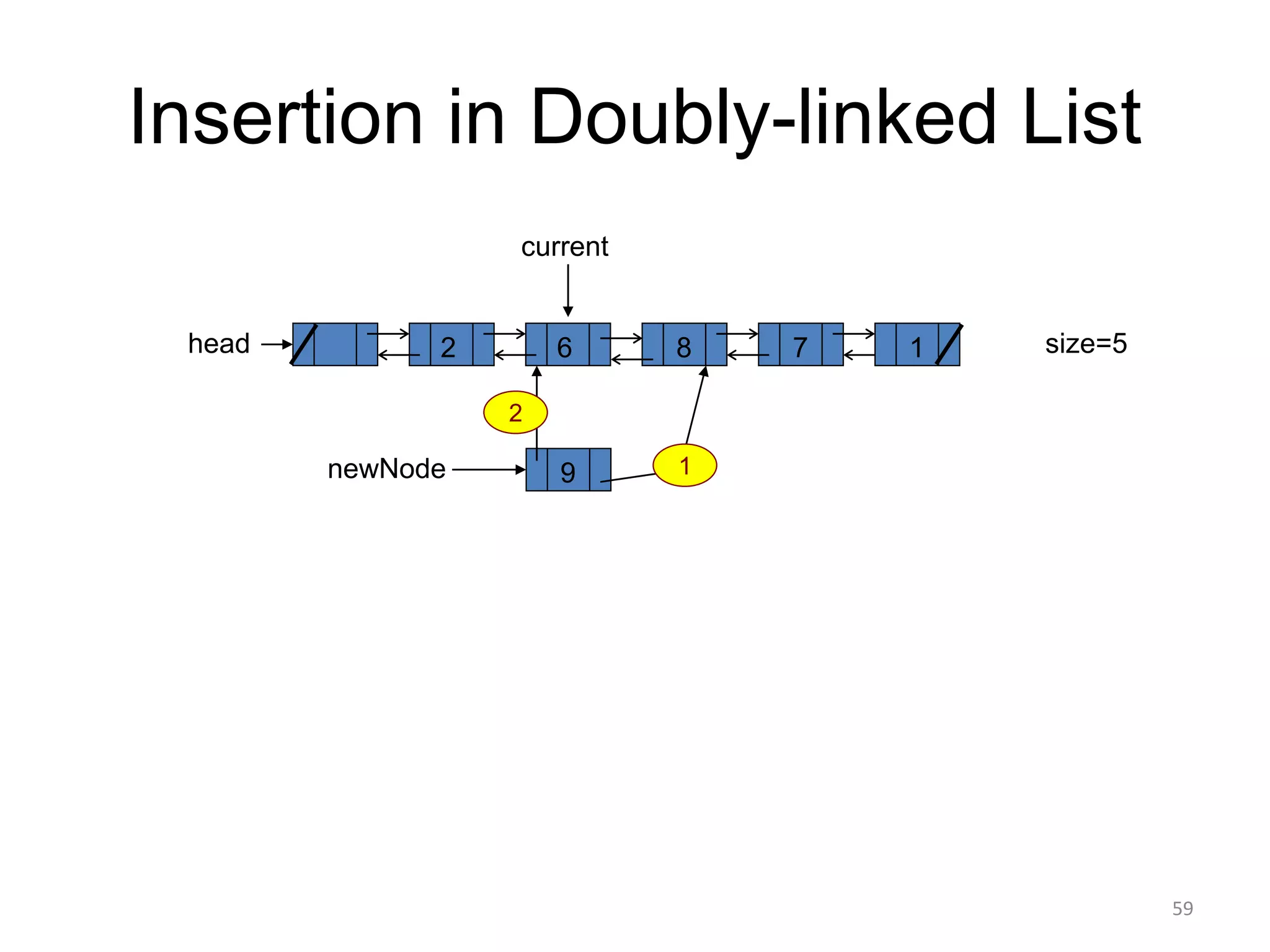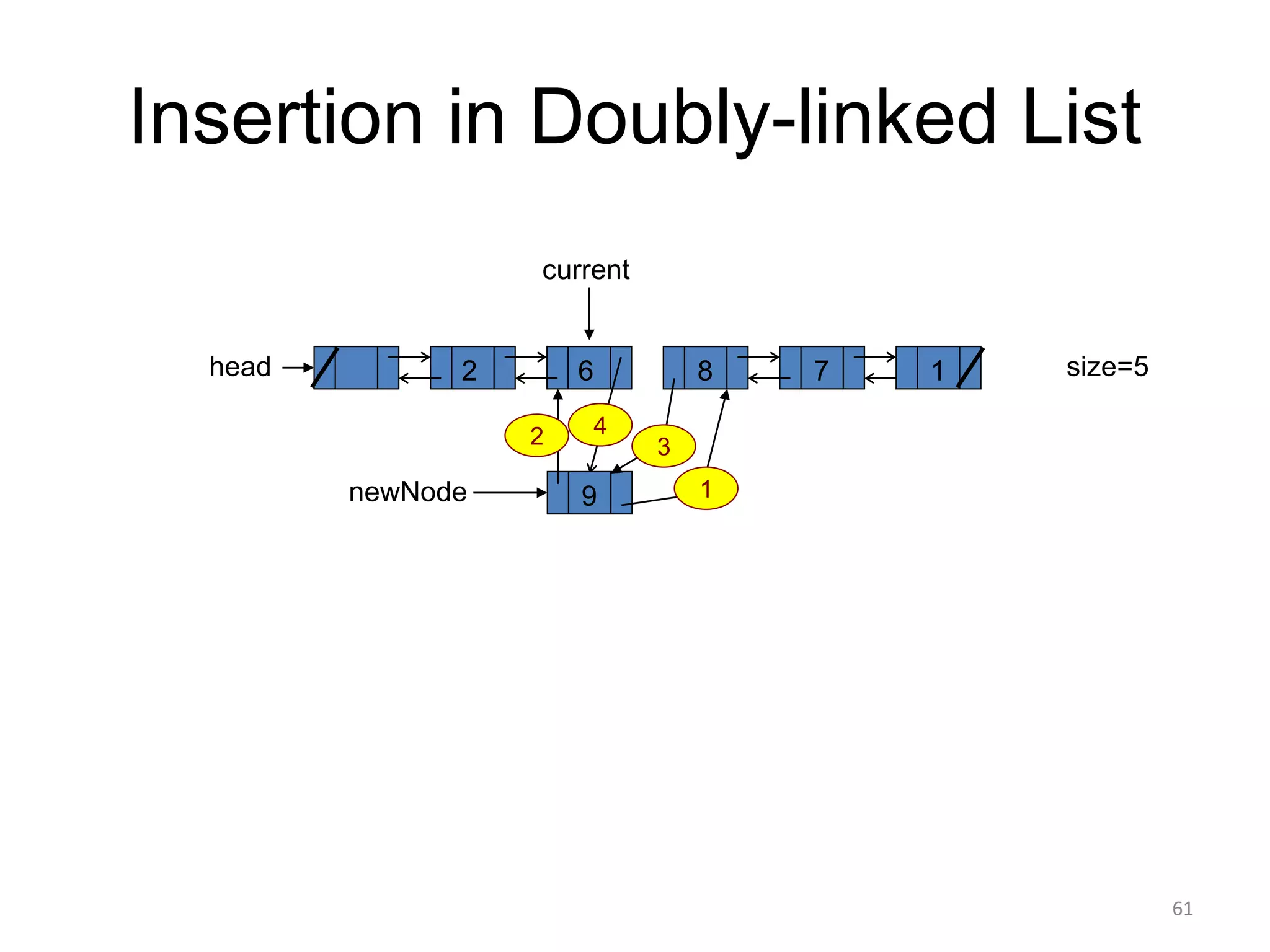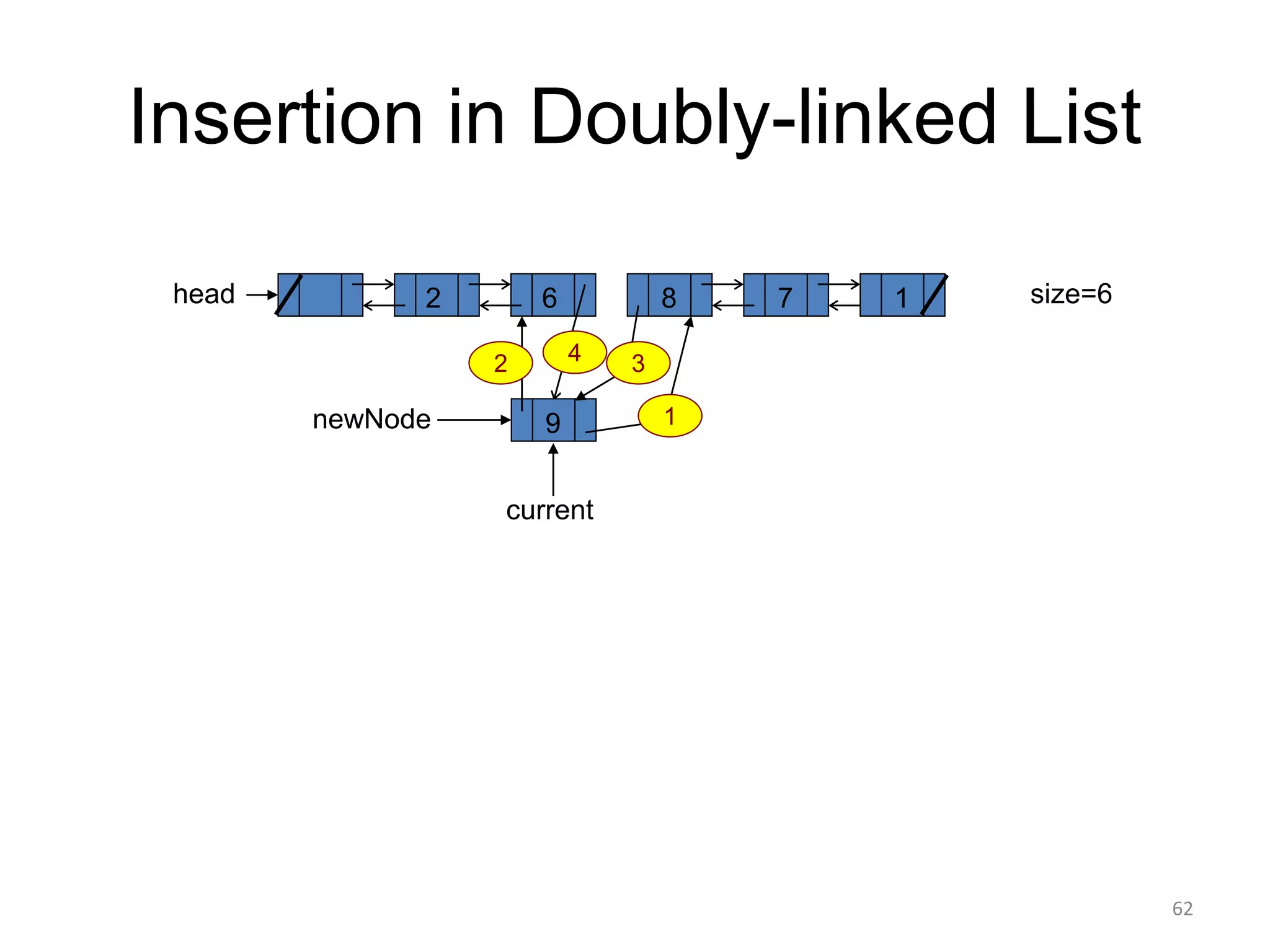This document summarizes a lecture on arrays and linked lists. It discusses arrays, including how to declare and access array elements. It then covers linear arrays and 2-dimensional arrays. Linked lists are introduced, including how they are composed of nodes that link to the next node. Operations on linked lists like traversing, searching, inserting and deleting nodes are described. Doubly linked lists are also covered, which include pointers to both the next and previous nodes.
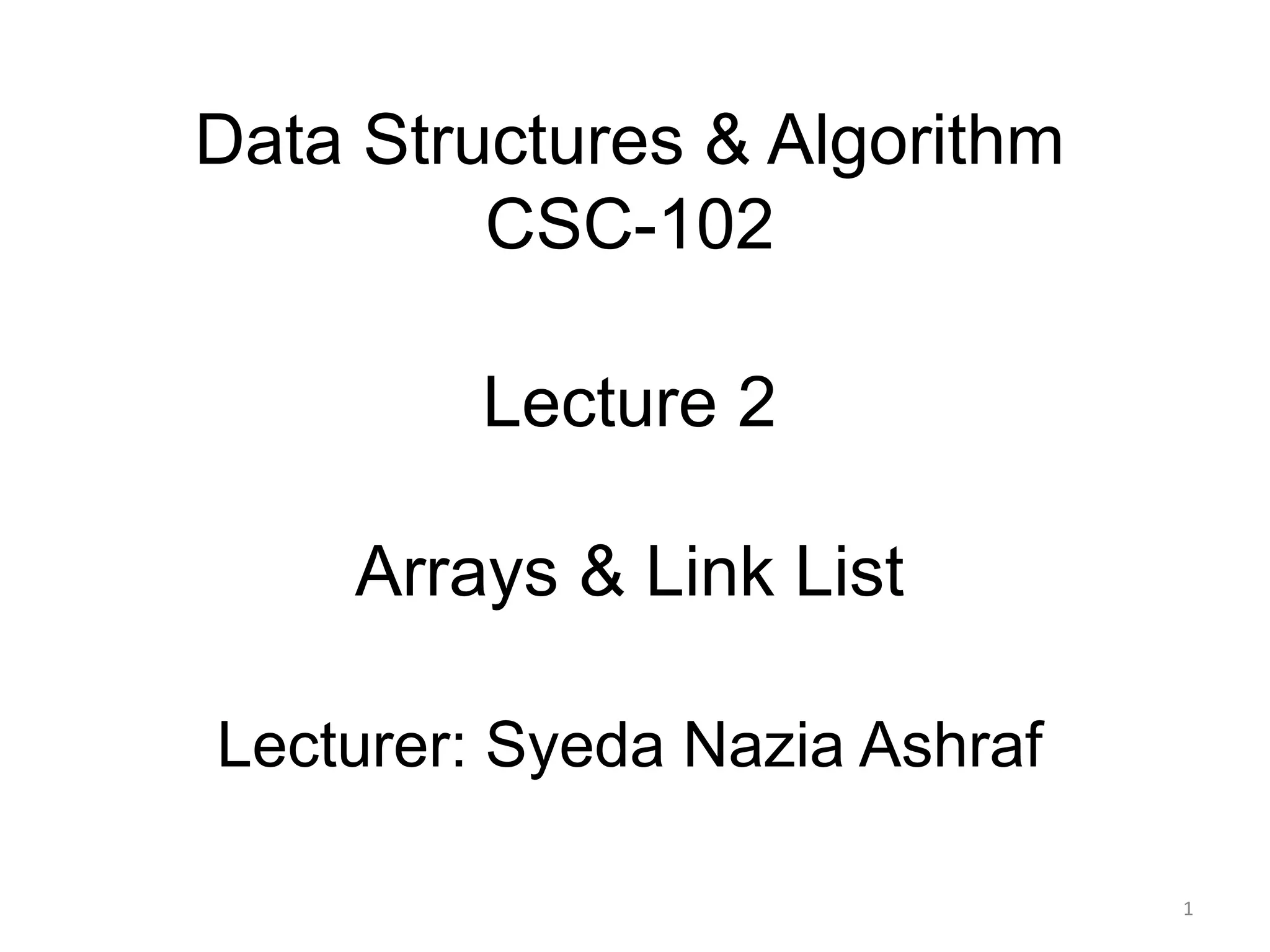
![Arrays
▪ Array declaration: int x[6];
▪ An array is collection of cells of the same type.
▪ The collection has the name ‘x’.
▪ The cells are numbered with consecutive
integers.
▪ To access a cell, use the array name and an
index:
x[0], x[1], x[2], x[3], x[4], x[5]
2](https://image.slidesharecdn.com/lect2-dsalgoonline-220407193017/75/lect-2-DS-ALGO-online-pdf-2-2048.jpg)
![Array Layout (Linear-array)
x[1]
x[2]
x[3]
x[4]
x[5]
x[0]
Array cells are
contiguous in
computer memory
The memory can be
thought of as an
array
3](https://image.slidesharecdn.com/lect2-dsalgoonline-220407193017/75/lect-2-DS-ALGO-online-pdf-3-2048.jpg)
![Linear(1-Dimensional Array)
A linear array A[8] consisting of numbers is pictured
in following figure.
4
A linear array STUDENT consisting of the names of
six students STUDENT[1] denotes John Brown,
STUDENT[2] denotes Sandra Gold, and so on.](https://image.slidesharecdn.com/lect2-dsalgoonline-220407193017/75/lect-2-DS-ALGO-online-pdf-4-2048.jpg)
![2-Dimensional Array
5
A chain of 28 stores, each store having 4 departments, may lists its weekly
sales first subscript denotes the store and the second subscript the
department. SALES is the name given to the Array.
SALES[1,1]=2872, SALES[1,2]=805, SALES[1,3]=3211,……..,SALES[28,4]=282
The size of this array is denoted by 28 X 4 (read 28 by 4), since it contains 28 rows
(the horizontal lines of numbers) and 4 columns (the vertical lines of numbers).
Such arrays are called Matrices in mathematics, and tables in business
applications.](https://image.slidesharecdn.com/lect2-dsalgoonline-220407193017/75/lect-2-DS-ALGO-online-pdf-5-2048.jpg)

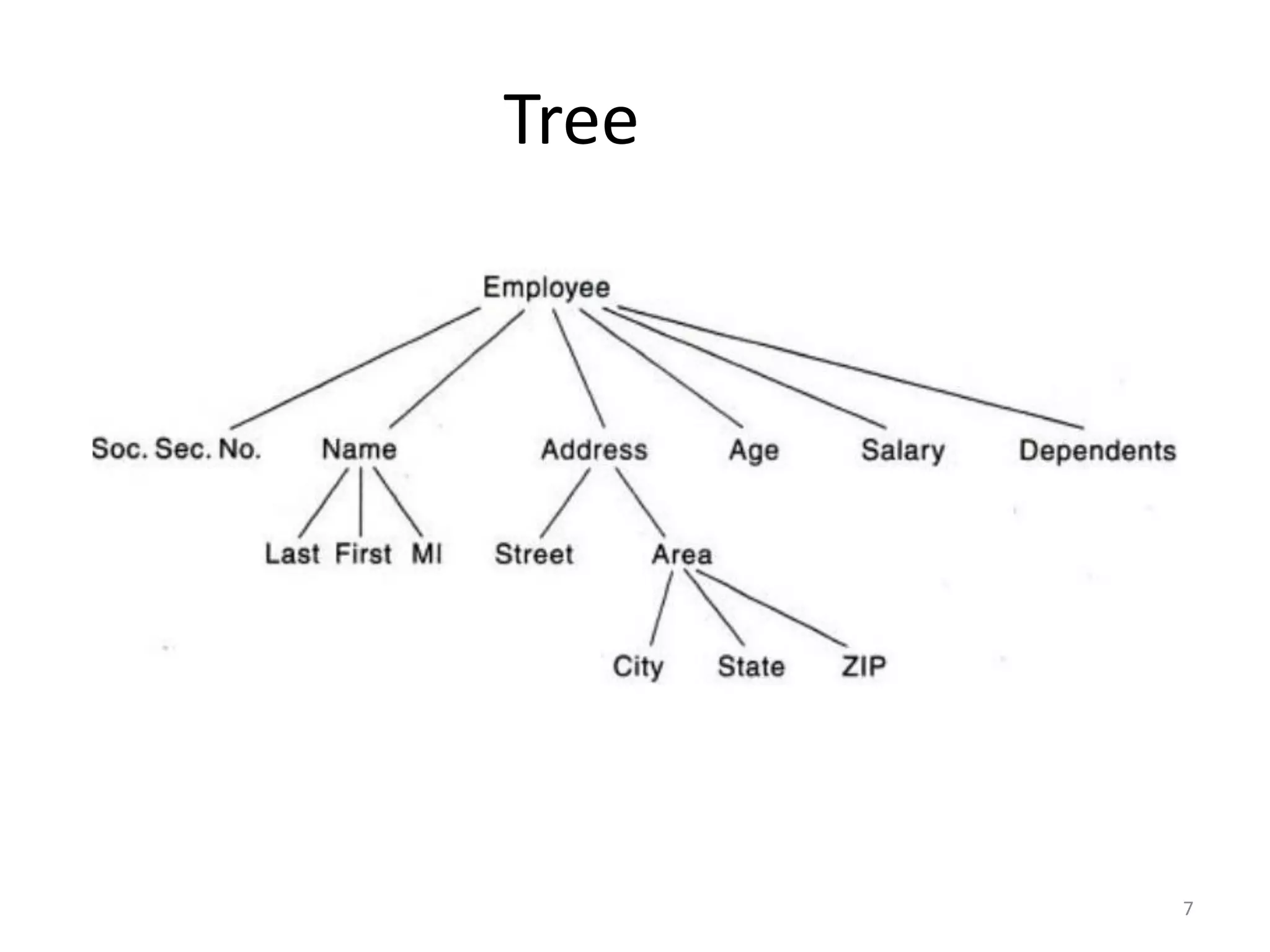

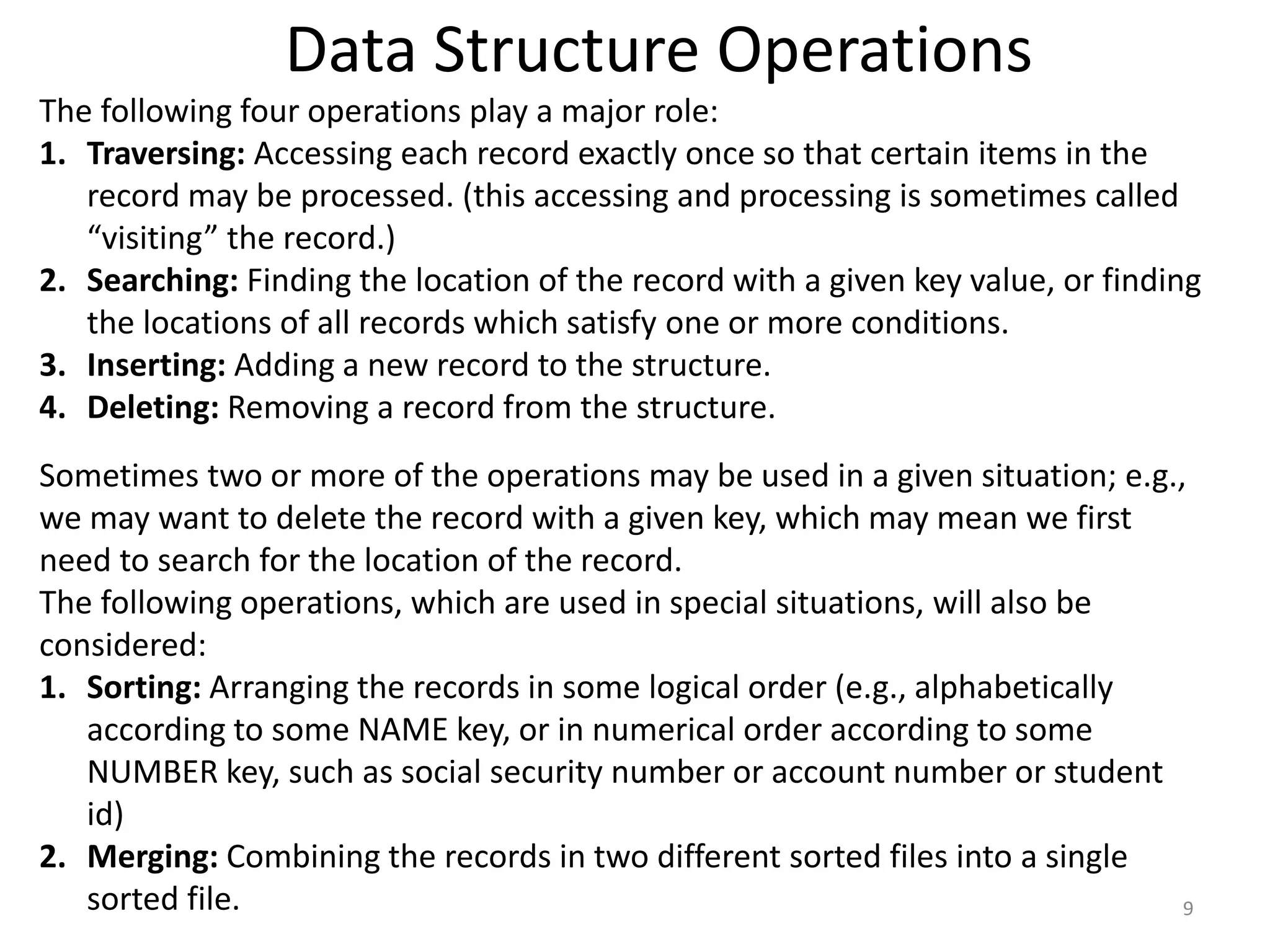
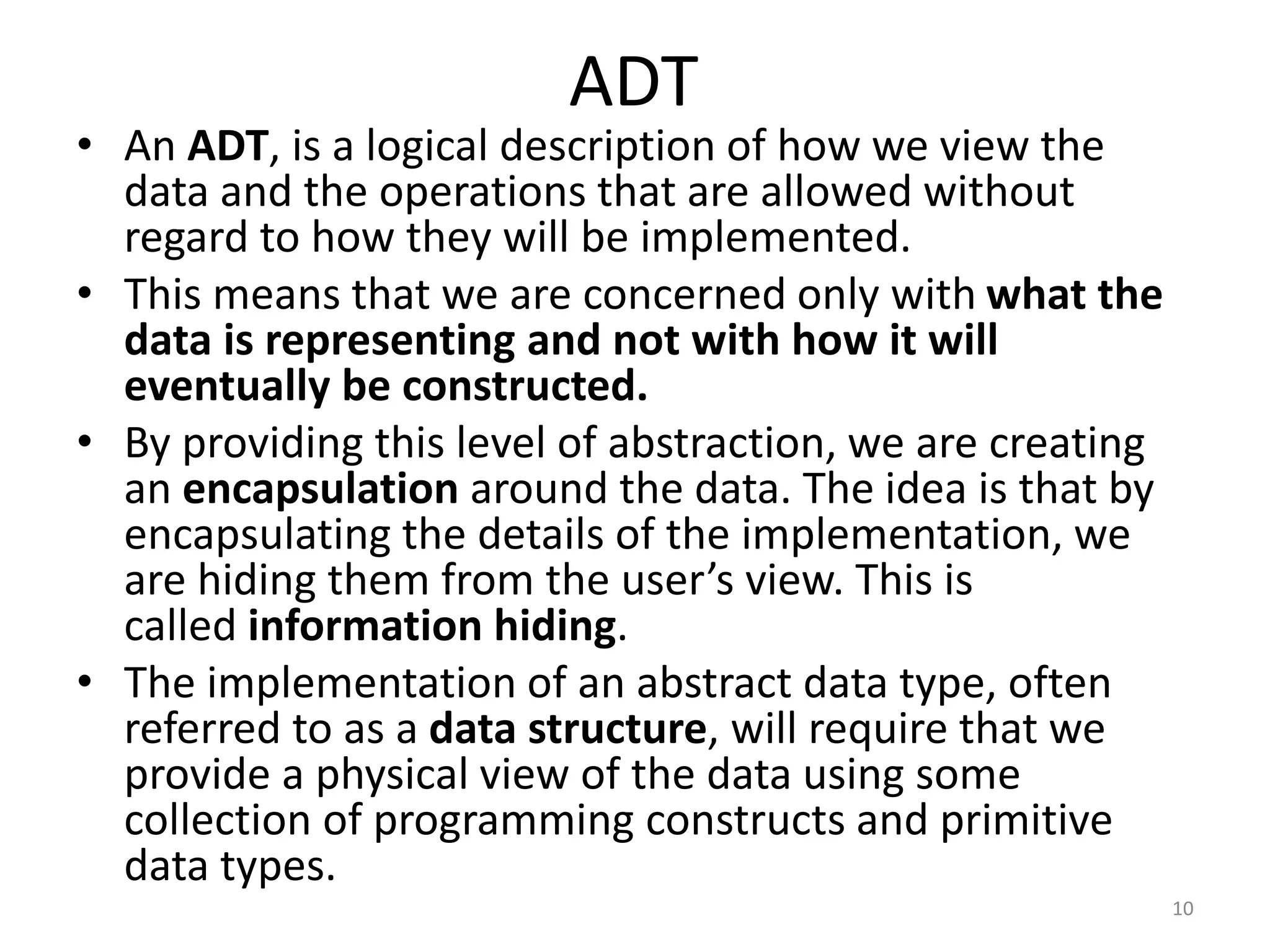

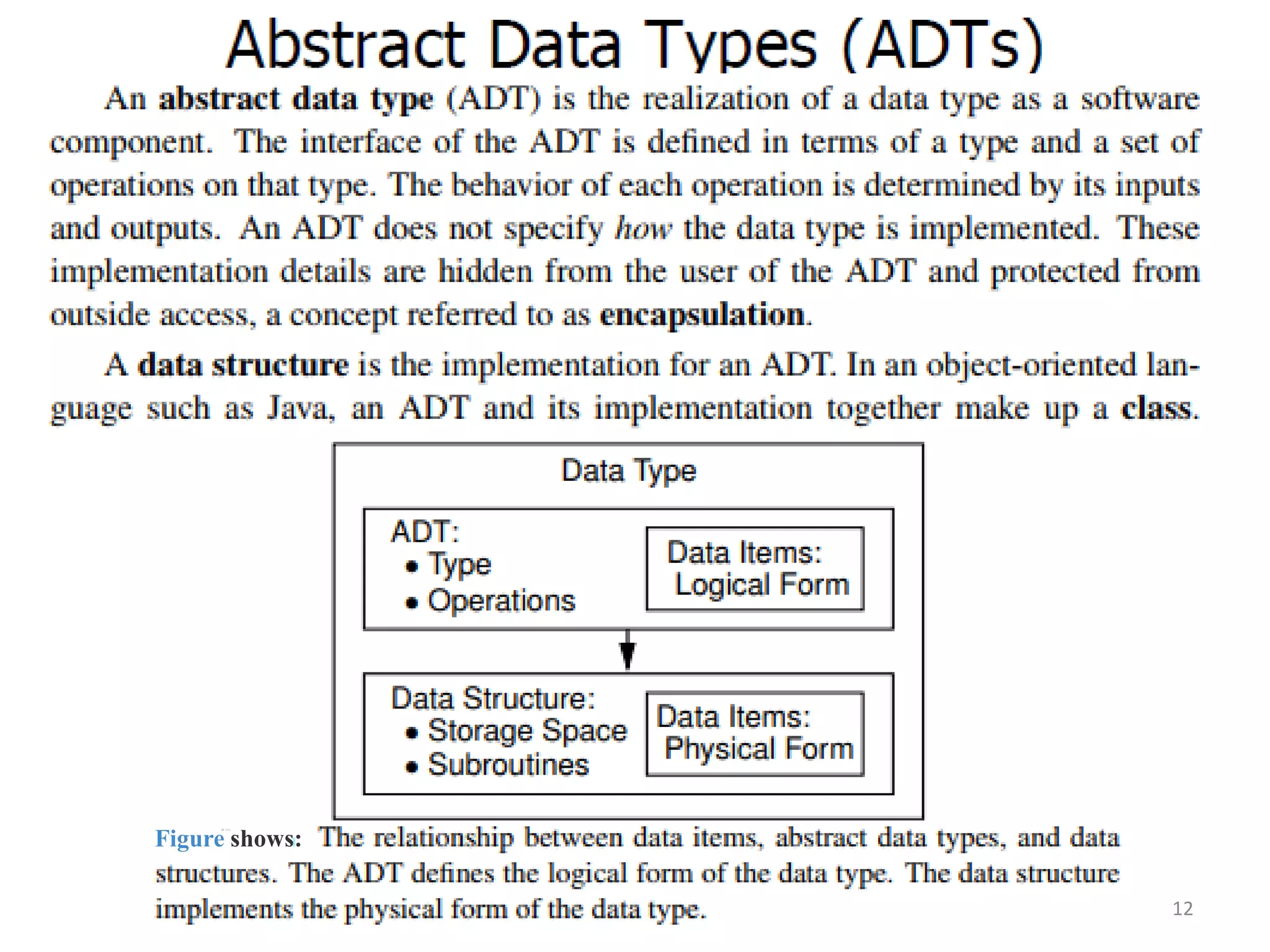
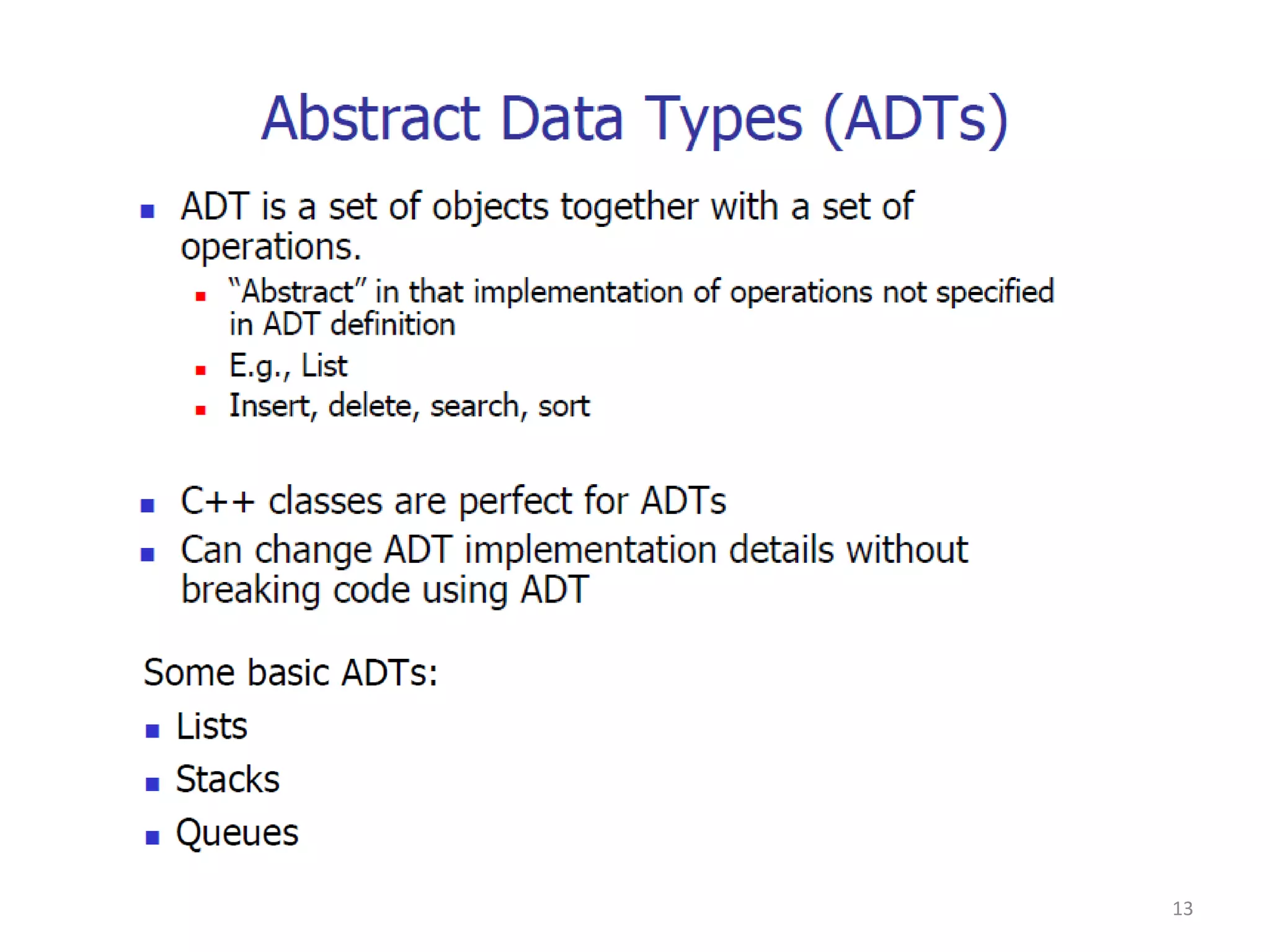

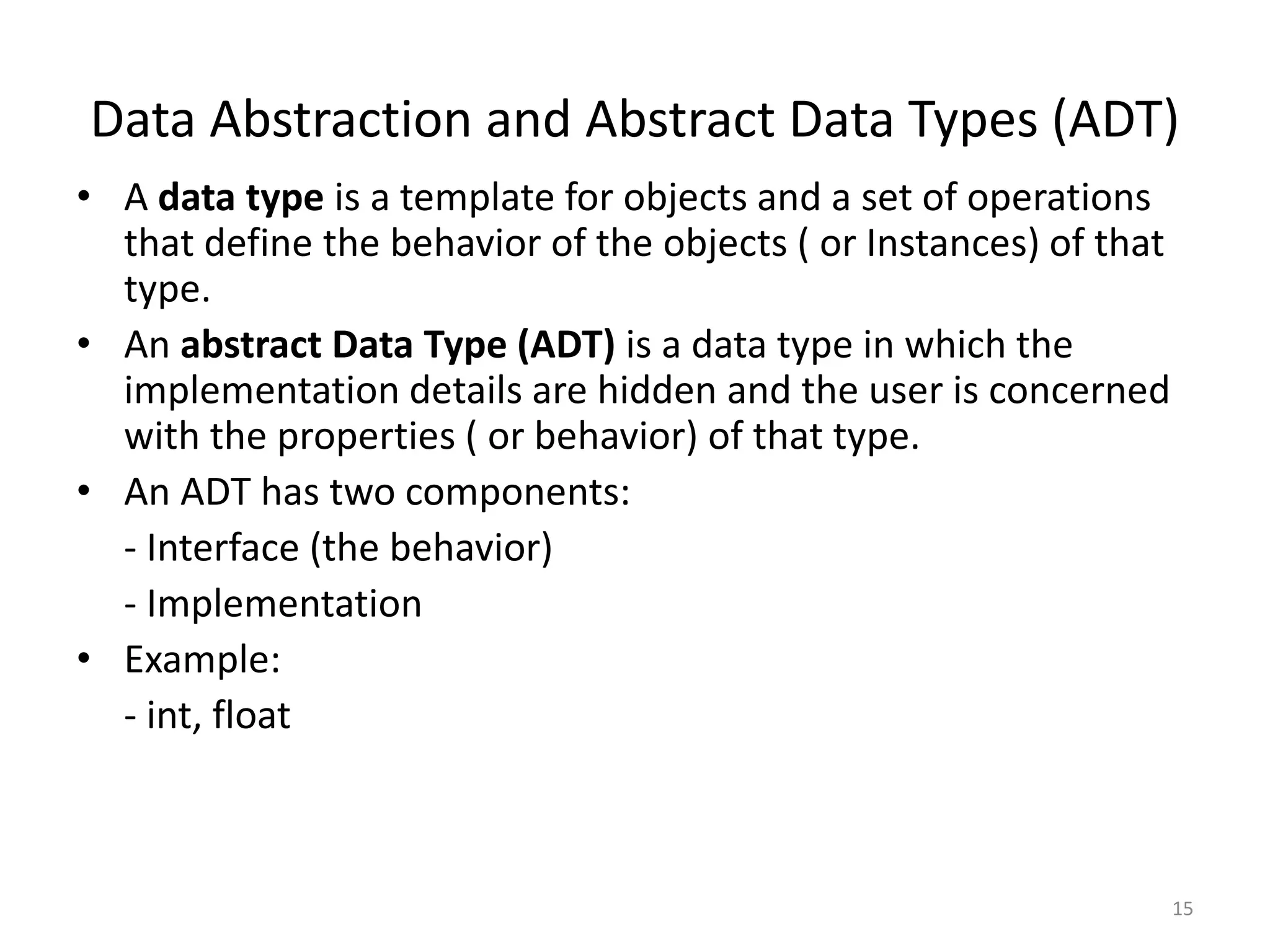
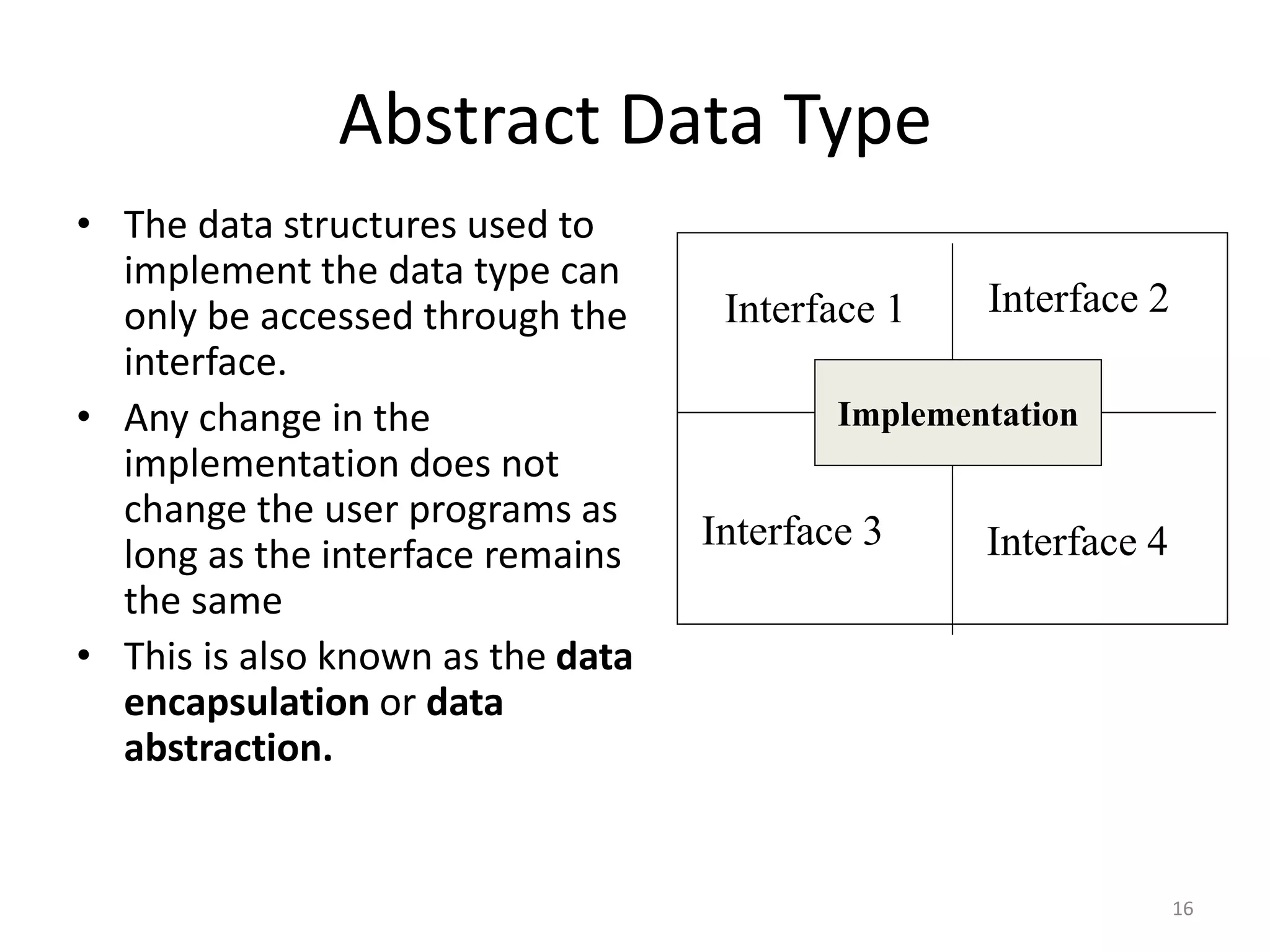
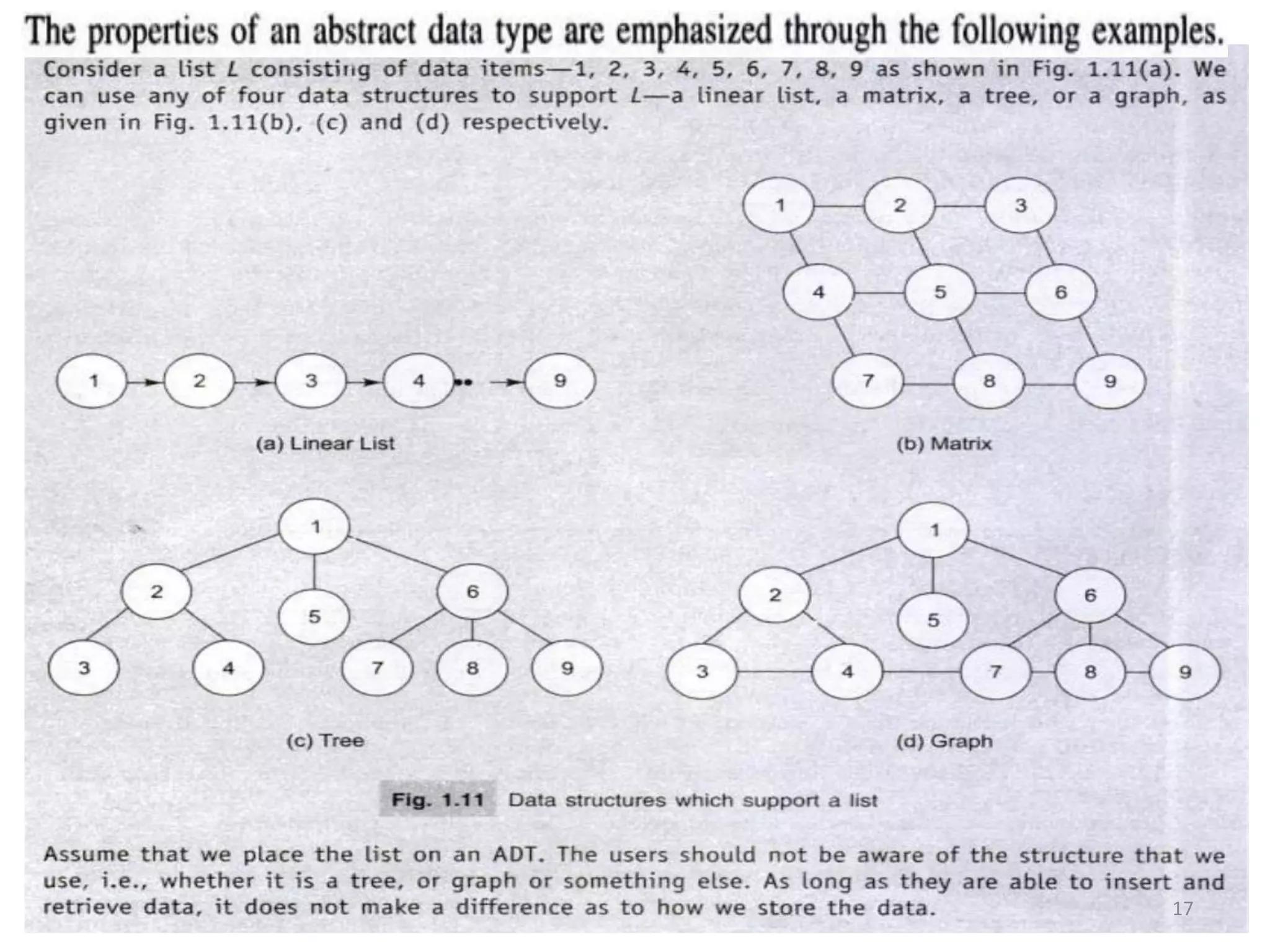
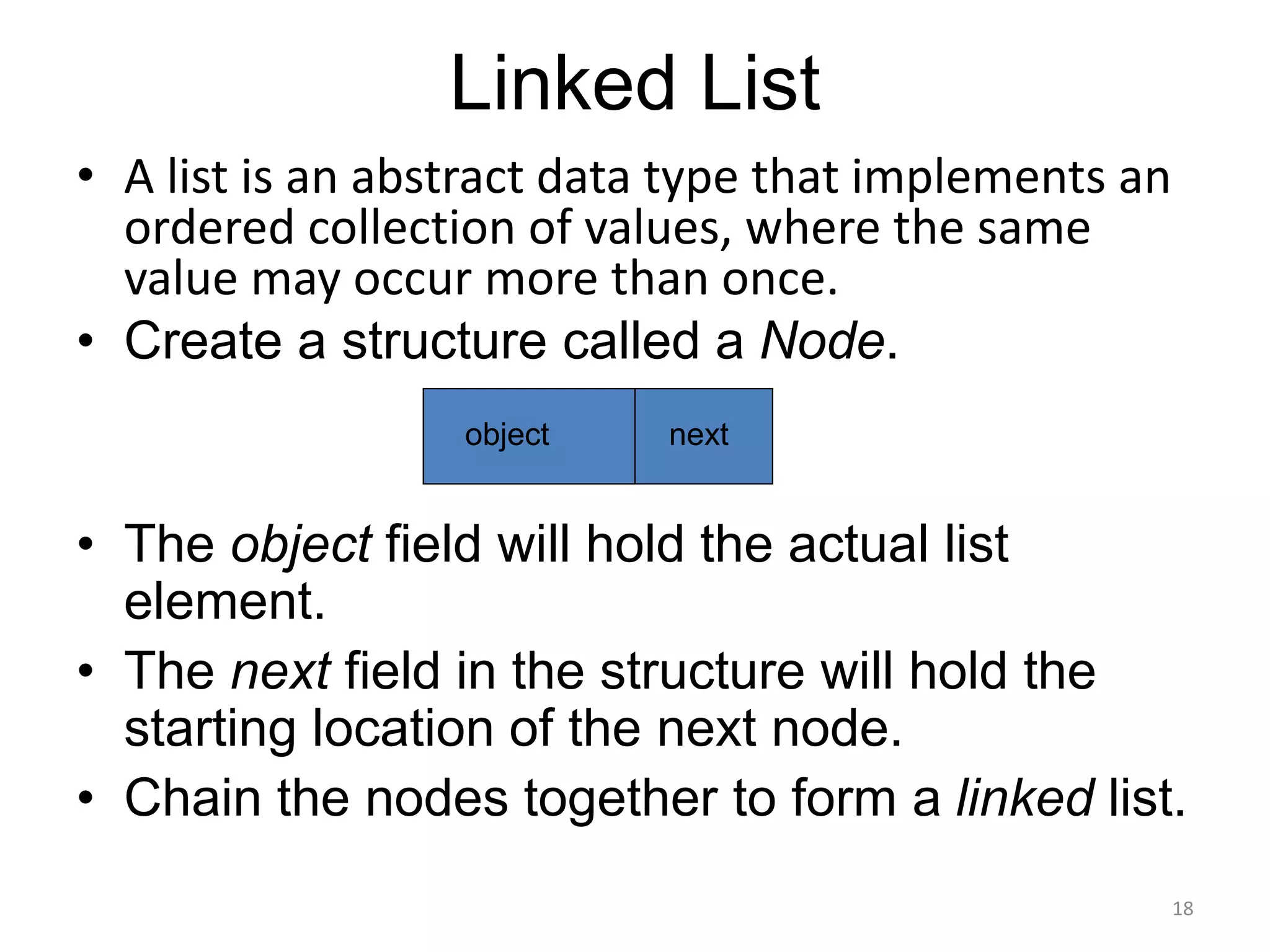
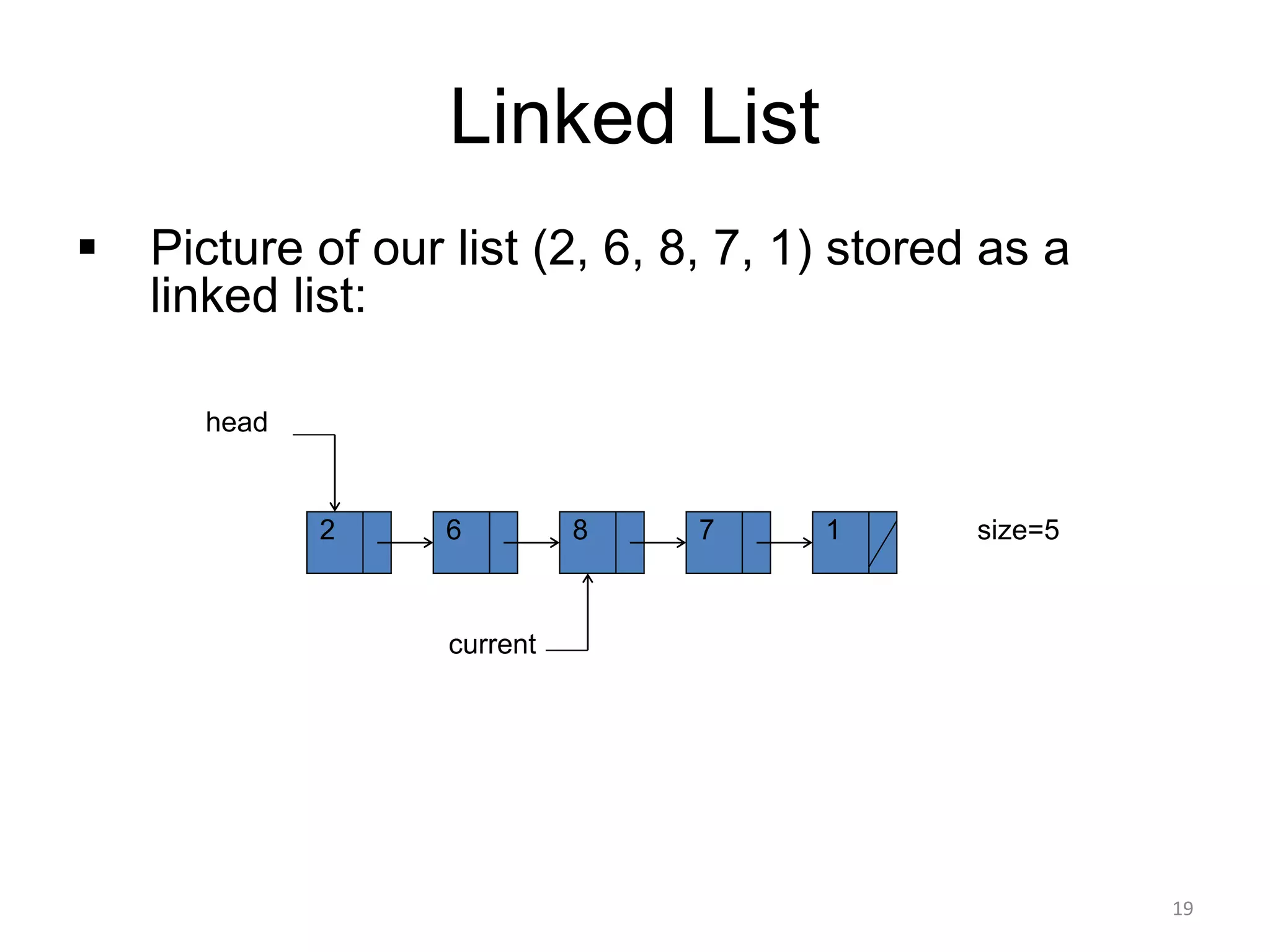
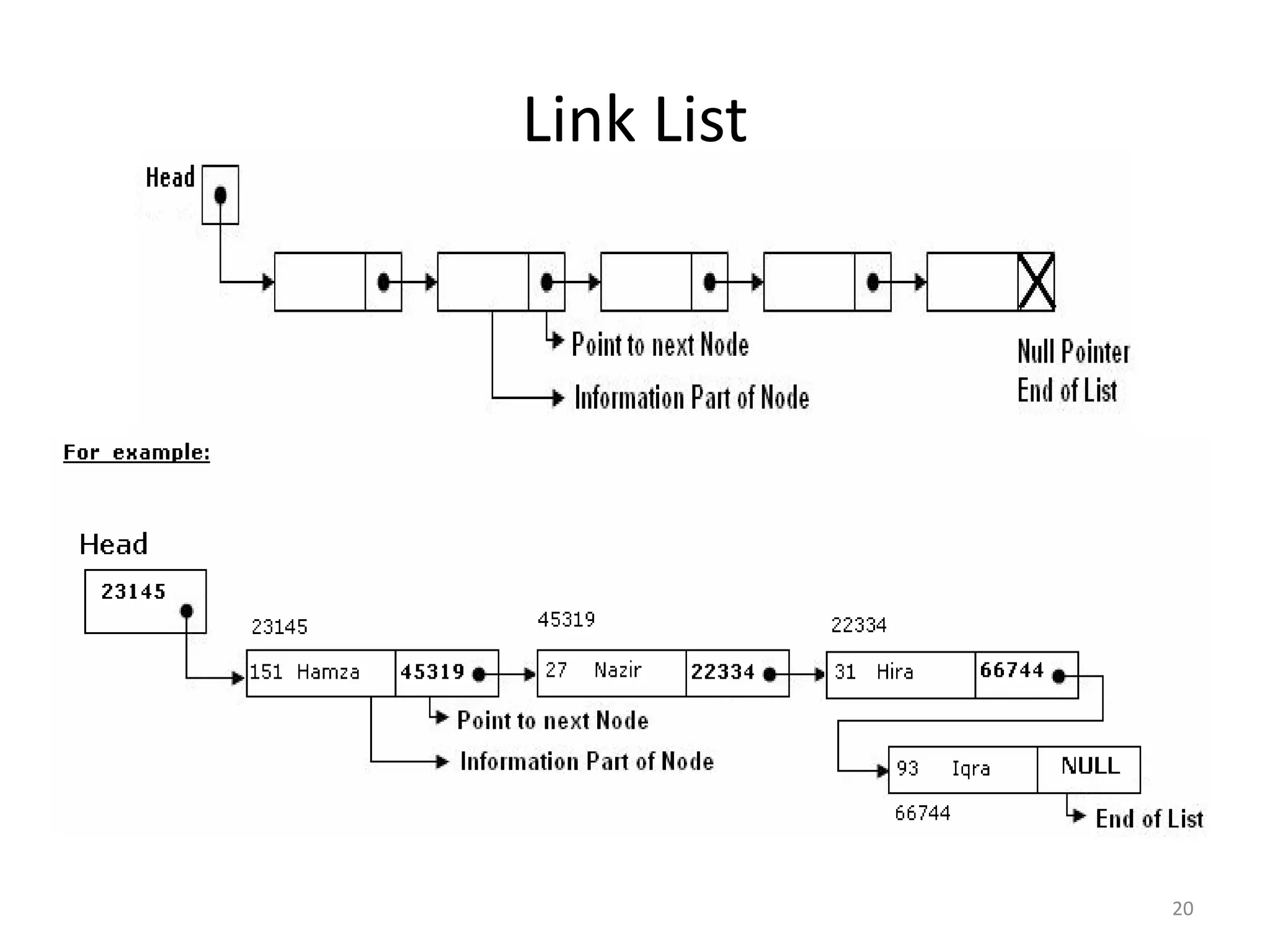
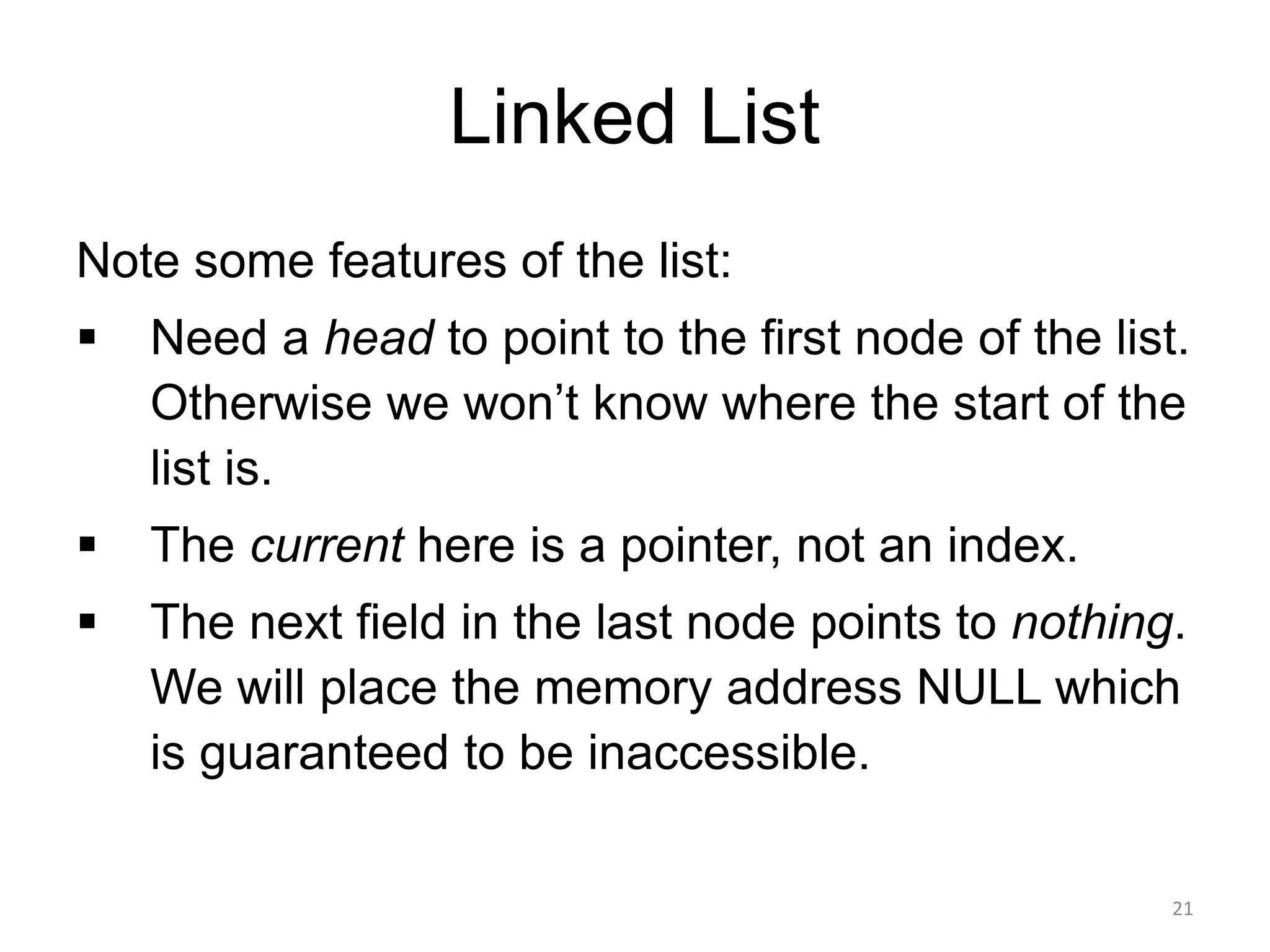
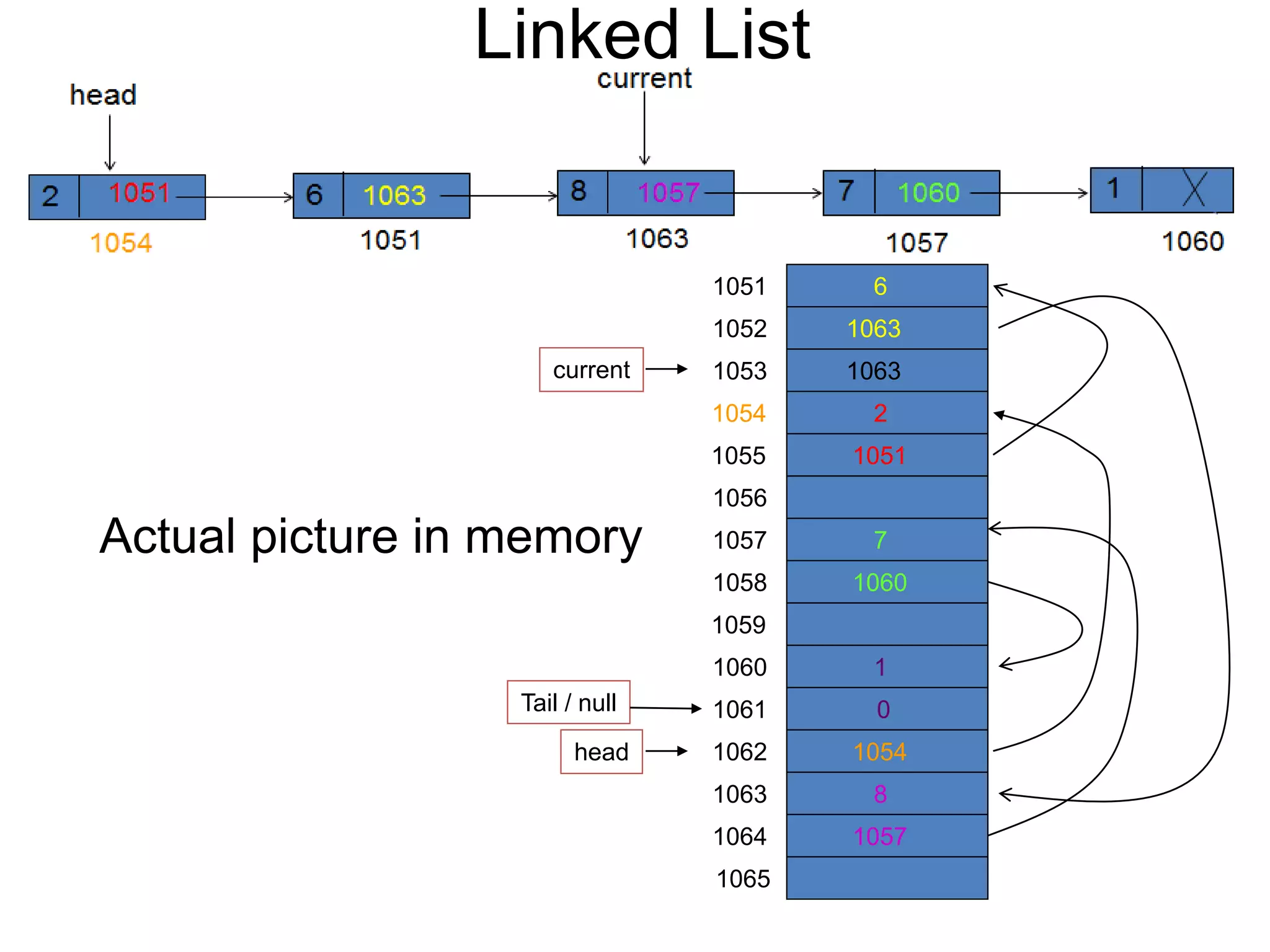
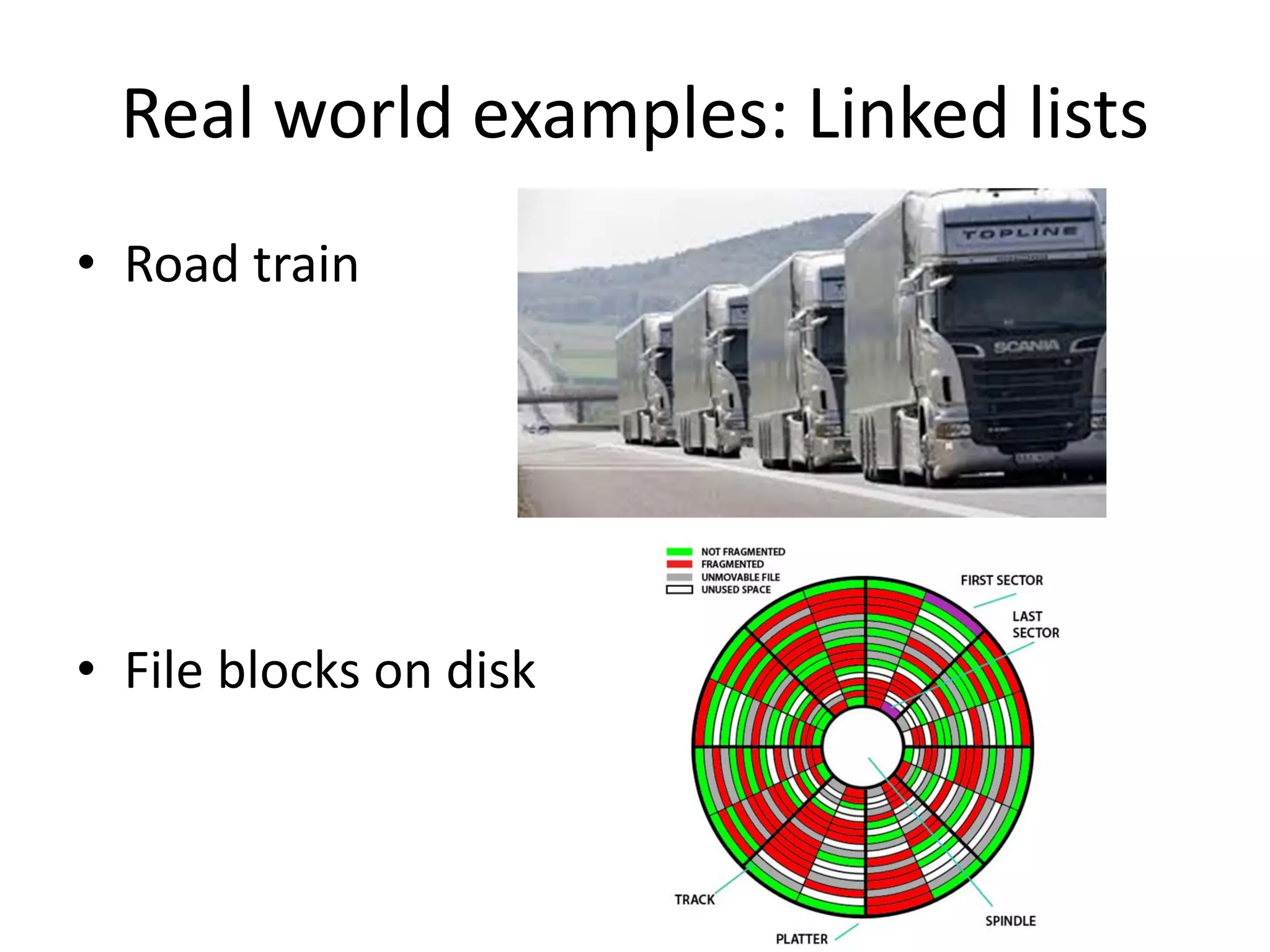
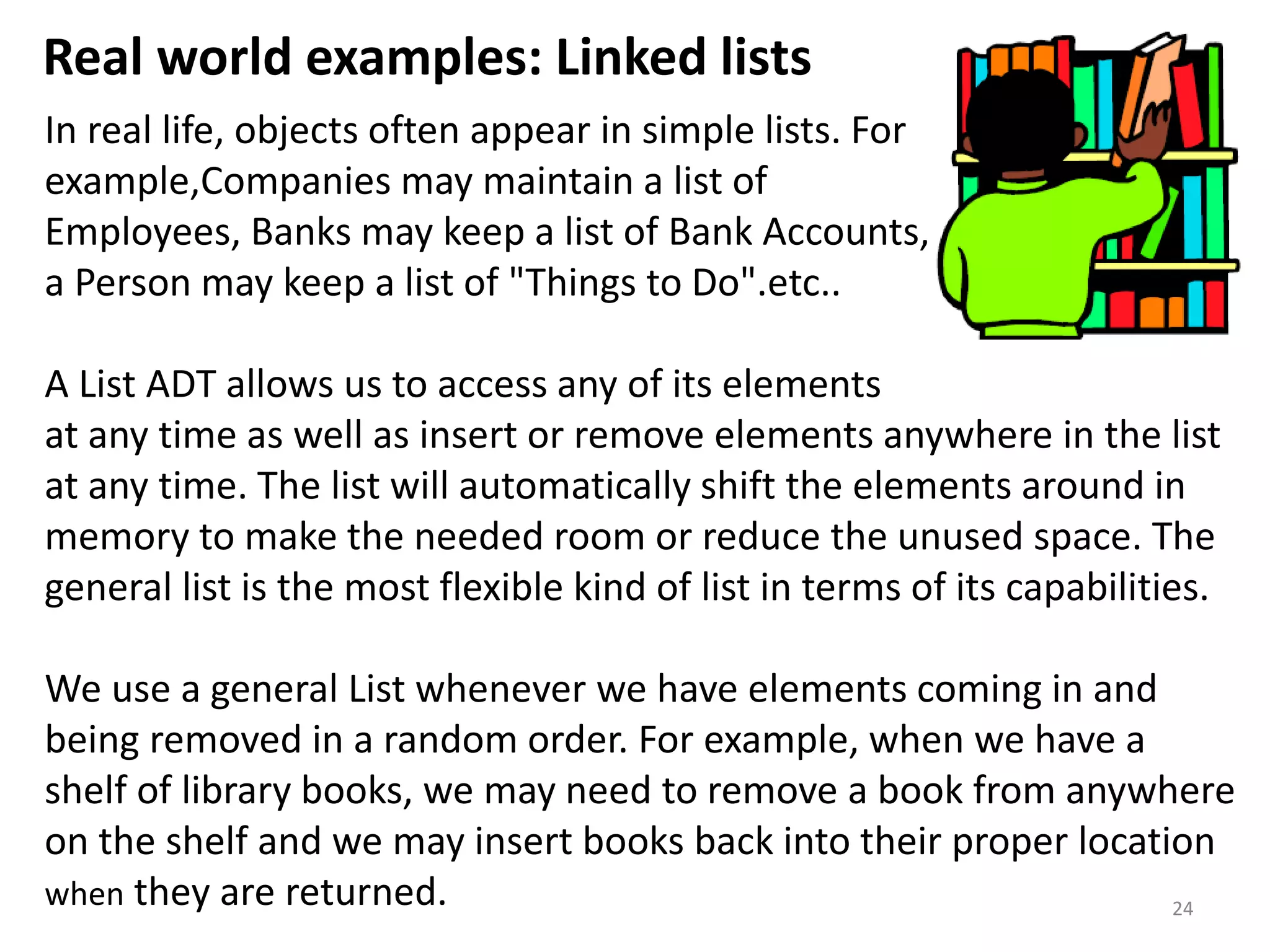
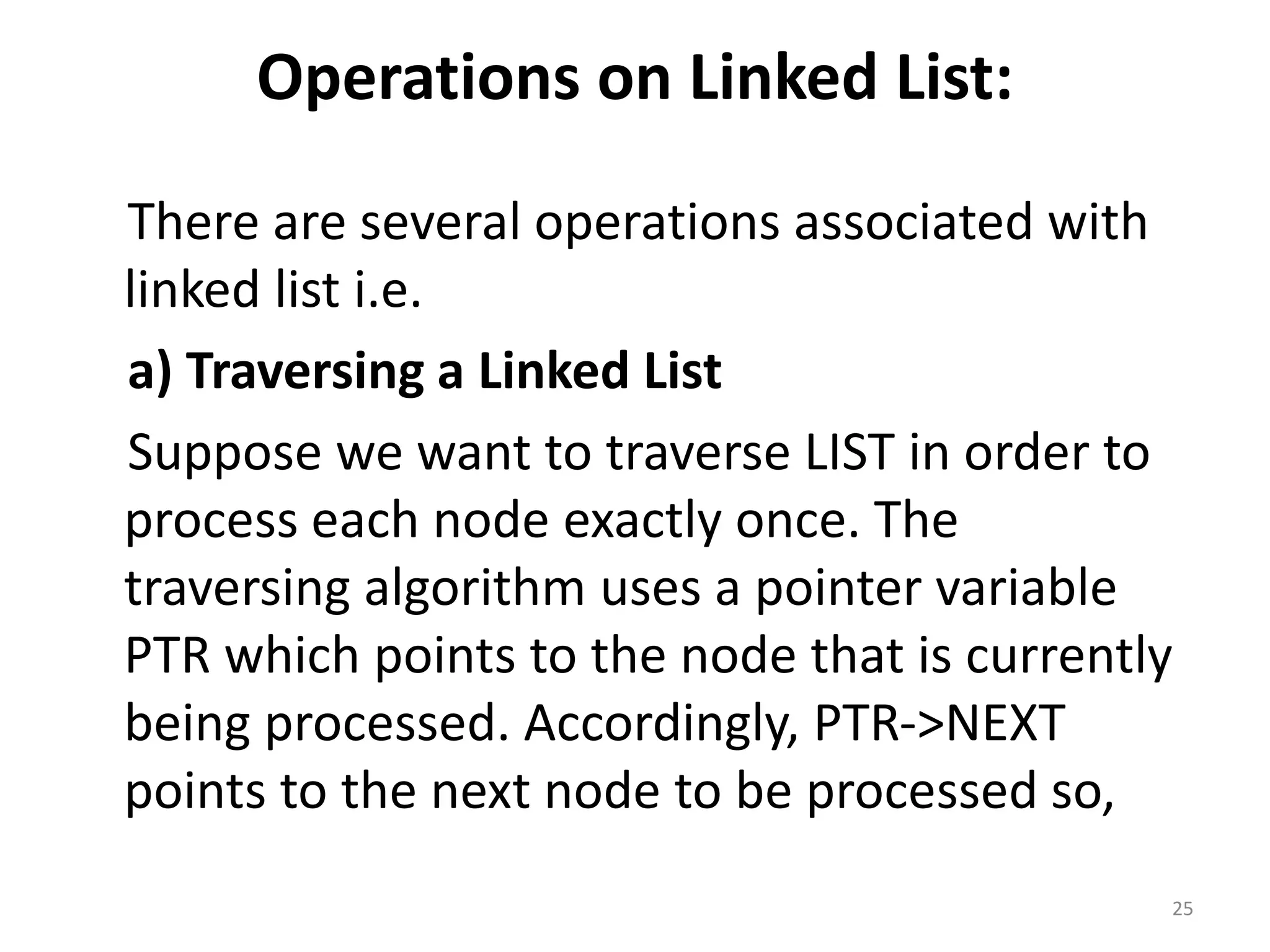
![26
PTR:=START [ Moves the pointer to the first node of the
list]
PTR:=LINK[PTR] [ Moves the pointer to the next node in
the list.]
INFO[PTR] [Process information at the node]](https://image.slidesharecdn.com/lect2-dsalgoonline-220407193017/75/lect-2-DS-ALGO-online-pdf-26-2048.jpg)

![28
Algorithm: (Traversing a Linked List) Let LIST be a
linked list in memory. This algorithm traverses LIST,
applying an operation PROCESS to each element of
list. The variable PTR point to the node currently
being processed.
1. Set PTR:=START. [Initializes pointer PTR.]
2. Repeat Steps 3 and 4 while PTR ≠ NULL.
3. Apply PROCESS to INFO[PTR].
4. Set PTR:= LINK[PTR]. [PTR now points to the
next node]
[End of Step 2 loop.]
5. Exit.](https://image.slidesharecdn.com/lect2-dsalgoonline-220407193017/75/lect-2-DS-ALGO-online-pdf-28-2048.jpg)
![29
b) Searching a Linked List:(UNSORTED LIST)
Suppose the data in LIST are not necessarily sorted. Then one searches for ITEM in LIST by
traversing through the list using a pointer variable PTR and comparing ITEM with the contents
INFO[PTR] of each node, one by one, of LIST. Before we update the pointer PTR by
PTR:=LINKPTR], we require two tests. First we have to check to see whether we have reached
the end of the LIST i.e. PTR=NULL. If not, then we check to see whether INFO[PTR]=ITEM.
The two tests cannot be performed at the same time, since INFO[PTR] is not defined when
PTR=NULL. Accordingly we use the First test to control the execution of a loop, and we let the
second test take place inside the loop.
Algorithm: SEARCH(INFO, LINK,START, ITEM, LOC)
LIST is a linked list in the memory. This algorithm finds the location LOC of the
node where ITEM first appear in LIST, or sets LOC=NULL.
1. Set PTR:=START.
2. Repeat Step 3 while PTR≠NULL:
3. If ITEM = INFO[PTR], then:
Set LOC:=PTR, and Exit. [Search is successful.]
Else:
Set PTR:=LINK[PTR]. [PTR now points to the next node]
[End of If structure.]
[End of Step 2 loop.]
4. Set LOC:=NULL. [Search is unsuccessful.]
5. Exit.](https://image.slidesharecdn.com/lect2-dsalgoonline-220407193017/75/lect-2-DS-ALGO-online-pdf-29-2048.jpg)
![30
b) Searching a Linked List:(SORTED LIST)
Suppose the data in LIST are sorted. Again we search for ITEM in LIST by traversing the list using
a pointer variable PTR and comparing ITEM with the contents INFO[PTR] of each node, one by
one, of LIST. Now, however, we can stop once ITEM exceeds INFO[PTR]. (List sorted in
descending order)
Algorithm: SRCHSL(INFO, LINK,START, ITEM, LOC)
LIST is sorted list in memory. This algorithm finds the location LOC of the node
where ITEM first appear in LIST, or sets LOC=NULL.
1. Set PTR:=START.
2. Repeat Step 3 while PTR≠NULL:
3. If ITEM < INFO[PTR], then:
Set PTR:=LINK[PTR]. [PTR now points to the next node]
Else If ITEM=INFO[PTR],then
Set LOC:=PTR, and Exit. [Search is successful.]
Else:
LOC:=NULL , and Exit. [ITEM now exceeds INFO[PTR].]
[End of If structure.]
[End of Step 2 loop.]
4. Set LOC:=NULL.
5. Exit.](https://image.slidesharecdn.com/lect2-dsalgoonline-220407193017/75/lect-2-DS-ALGO-online-pdf-30-2048.jpg)
